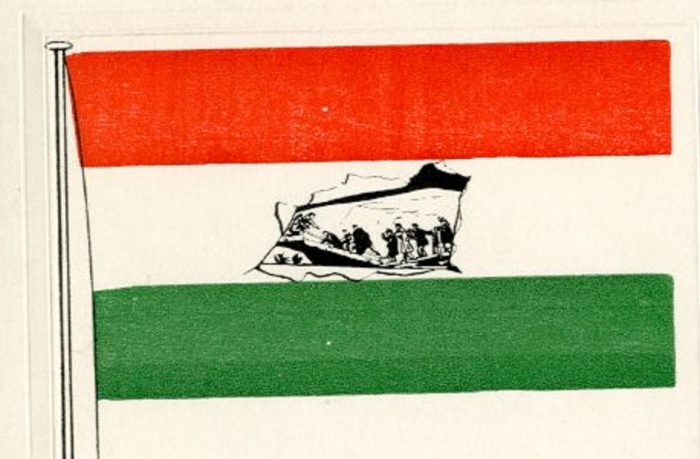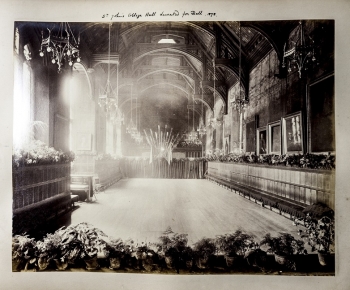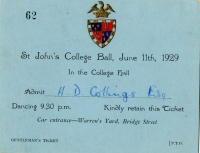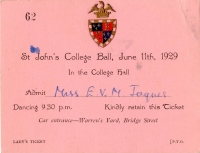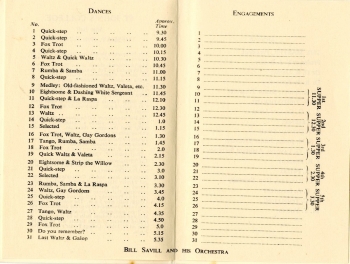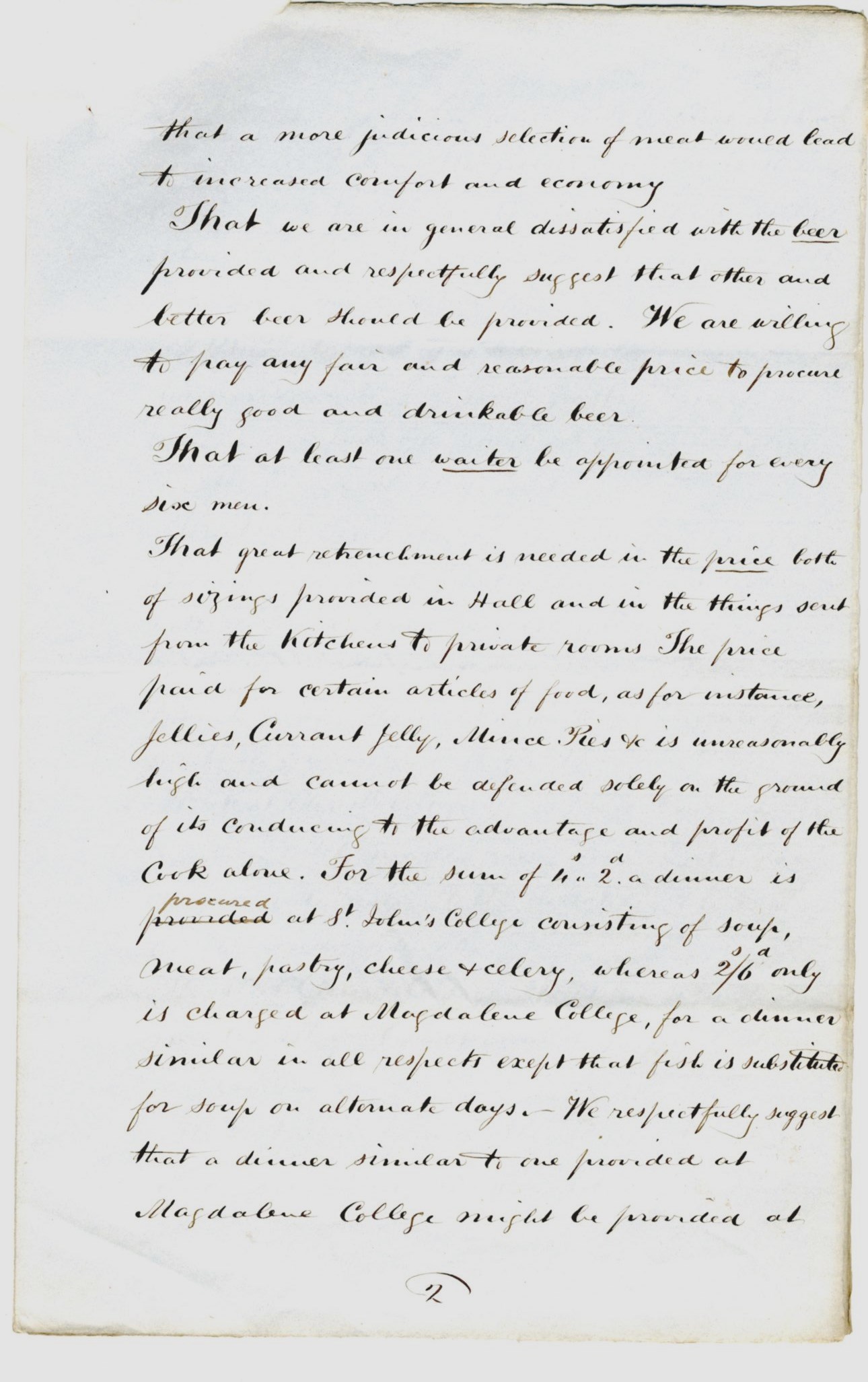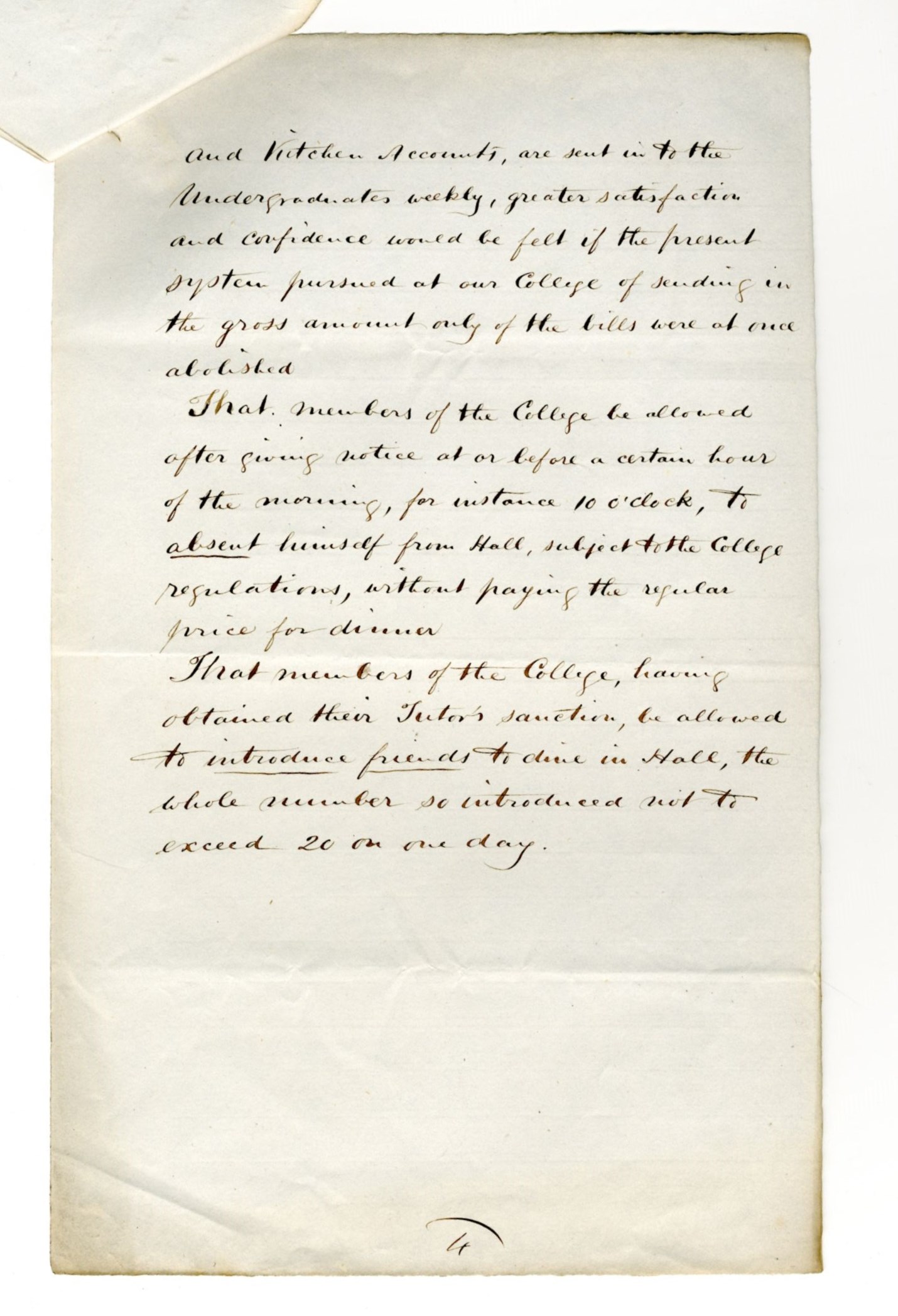Off the shelf
St John's College Mission
On the 28th January 1883, the Rev. William Whitworth, English mathematician and Fellow of St. John’s College, delivered a sermon in the College Chapel, entitled "The Victims of Ignorance and the Trustees of Knowledge”. In a stern address to the congregation, Whitworth identified ignorance as the root of human transgression, the source of sin, suffering and penury. Only through the dissemination of knowledge, he argued, could society escape the bonds of such evil, and those in possession of knowledge, the special “trustees” of learning, had a moral responsibility to bring their knowledge to ignorant and disadvantaged communities:
"And so, my brethren, who with the privilege of residence in this ancient seat of learning possess so much more knowledge than the pastoral and missionary clergy can aspire to, when you come to sojourn for a few weeks in that great wilderness of London, or in any other great town, could you not (whether in conjunction with the parochial clergy or independently of them), by lecture or by conference with the working classes, or by visiting them in their clubs, do more than is being done at present to dispel the ignorance by which the people are destroyed, and to acquit yourselves as the trustees of knowledge?"[1]
A pamphlet copy of Whitworth’s sermon, part of a collection of documents held in the St. John’s College Archives, helps us to trace the fascinating early history of the St. John’s College Mission. Capturing the missionary mood of the period, Whitworth’s sermon was later lauded as the driving impetus with which the College Mission, an enterprise which would last for more than fifty years from 1883 to 1940, was first established
Social reform and charitable endeavours in large industrial cities such as London and Manchester had sought to address significant problems in education, sanitation and public health from the mid- nineteenth century onwards. The Mission of St. John’s College, the first such mission of its kind to be undertaken by any Cambridge College, aimed to provide immediate relief for the poor in the form of food, clothing, medicine, and toys for children, as well as the practical, academic and spiritual knowledge of the kind that existed at the heart of Whitworth’s message. We know that students and alumni were encouraged to go down to London, for example, as well as to register as subscribers who could offer regular financial contributions to the cause. Given the founding pedagogical principles and values of the Mission, there was a special focus on educating parishioners through lectures and sermons.
To begin with, the pioneers of the Mission worked in the parish of St. John’s in Walworth, London. By 1890, however, the Mission’s size and scope had grown to such an extent that the Mission was able to oversee the foundation of the Parish of the Lady Margaret, together with the construction of a new church building.
The Governing Committee for the College Mission considered several possible locations before agreeing to settle in Walworth. Influenced by the work of the nineteenth-century social reformer, Charles Booth, this hand-drawn copy of a poverty map of central London reflects the careful process by which the Committee selected Walworth as a worthy recipient of its beneficence, while also highlighting the growth of other similar missions across the capital.
The early work of the Mission was reported in The Eagle for Lent 1884, which described the renovation of Mission Church and some of the events that took place there. On Mondays, “there is a Mothers’ Meeting, which has from 30 to 40 regular frequenters” while the ‘Cambridge Club’ for working men “opened on the 21st April with nearly 50 members. Nominal charges are made to visitors and also for some of the games […] On a recent date some past and present Johnians met at the Club, and did their best to entertain the members in a friendly and informal manner with readings and songs. The visitors expressed themselves thoroughly gratified by the evening” (p.3)
The report also included a call for donations, with some stipulations: “In addition to the two standing requirements of money and workers, Mr Phillips asks for (1) Old clothes, (2) Worked clothes. Ladies kind enough to undertake this work are respectfully requested to make the garment of ordinary proportions, remembering, for instance, that a giant’s arms are seldom attached to a dwarf’s body. This caution is found necessary” (p3-4)
Books for the Sunday school library, flowers for distribution, letters of admission to Hospitals and Convalescent Homes, coloured pictures and old scrap-books were likewise welcomed. The report concludes with an appeal for the assistance of men during the long vacation, proposing that men spend at least a week in the service of the Mission. Tasks included helping at Sunday School and with Church services, organizing Bible classes for adults, giving addresses, visiting members of the community, almonry, helping at the ‘Cambridge Club’ and playing with the cricket club.[2]
The work of the College Mission at Walworth continued for another thirty years, and during that time, the Mission funded and coordinated a vast range of schemes and activities for men, women and children. By 1920, it had been decided that the Church of the Lady Margaret no longer required the Mission’s full assistance, although St. John’s College would retain a certain interest in and connection with the Parish.[3] Attention and subscriptions would now be diverted towards a new endeavour: the Maurice Hostel at Hoxton, London.
While faith and education remained central to the Mission at Hoxton, greater emphasis was now given to play as well. A copy of the ‘Hoxton Eagle’ (October 1935), edited by members of the Hoxton Boys’ Club, includes reports on sports and social activities, football and cricket matches.[4] Regular Whitsuntide visits to Cambridge were arranged, with College undergraduates volunteering to host boys for breakfast, lunch or dinner. Fundraising events, such as revues, concerts and Christmas toy donations, reflected the continued commitment of members to devise ever more inventive means of engaging with subscribers. The work of the Ladies’ Committee was especially influential.
The College Mission at Hoxton continued to play an active role through the course of the 1930s, but in 1940, its work was halted due to the pressures brought about by the Second World War. The aerial bombardment of London and mass evacuation of the city rendered the continuation of the Mission’s normal schedule of activities in Hoxton impossible, while the College had its own war-time preoccupations to address in Cambridge. Subsequent to 1945, the College Mission was never properly re-established, and though subscribers were given the option to withdraw their subscriptions in 1954, or to continue to subscribe in the event that another Mission be undertaken, this never happened and the Church of the Lady Margaret closed in 1977.
Today, the story of the College Mission is perhaps, for some, a less familiar one in the history of St. John’s. Yet at its height, the Mission was a substantial enterprise which relied on the goodwill and initiative of its patrons to bring about change in the communities it served. And while the names of the many individuals who benefitted from the work of the Mission are lost to us, it is hard not to feel moved by the accounts which survive of the sports days and children’s clubs, summer camps and evening classes, nor to imagine what difference all of these things meant to those who participated in them.
[1] SJCS/49/2/1/2/1 (p.11)
[2] SJCS/49/2/3/2
[3] The decision to transfer the focus of the Mission away from Walworth was primarily due to a substantial bequest that was left to the ‘Walworth Church Mission’ by E.L. Cobb after her death in October 1913. Elizabeth Cobb, widow to --- Cobb of Trinity College, and to Dr. Parkinson of St. John’s College before that, left a permanent endowment of £9000, which the Senior Treasurer of the College Mission continued to pay to the Lady Margaret Parish until 1939.
[4] SJCS/49/1/1/3
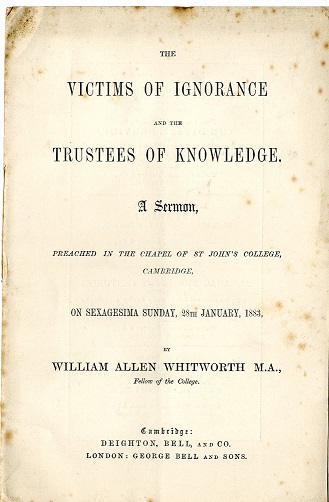
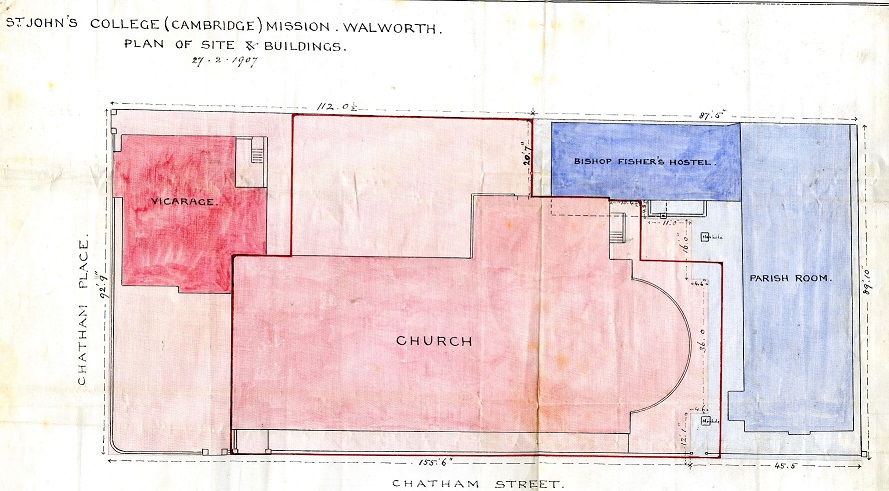
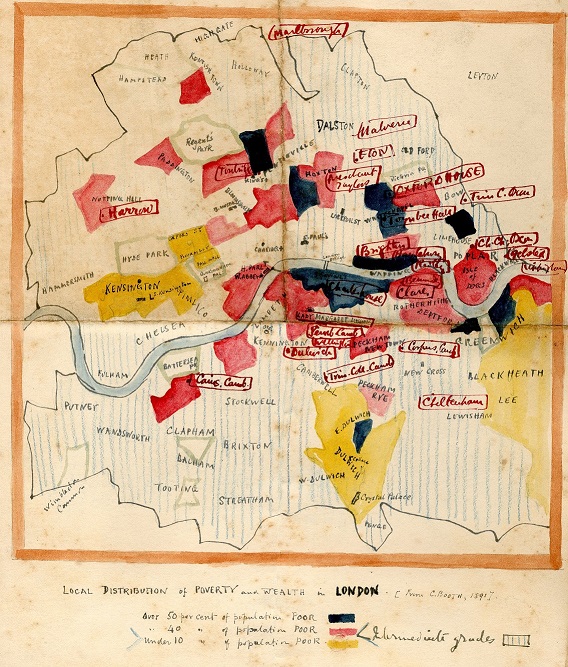
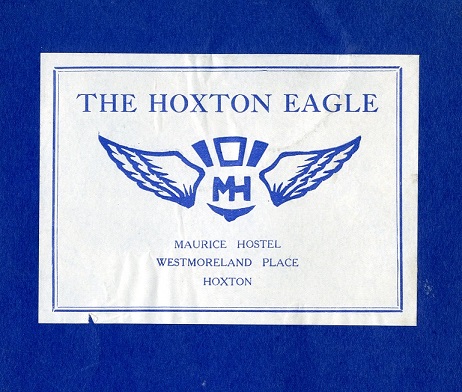
Trenches & Tankards: WWI Officer cadets at SJC
Taking a walk through the streets, greens and meadows of Edwardian Cambridge, one would have seen students in blazers and hats, earnest young men disputing classics or mathematics, fellows in gowns hurrying to give lectures. The centuries-old studious atmosphere of the city seemed imperturbable and impervious to change. In 1914, in Cambridge just as across Europe, that peace was shattered. As students and fellows were called to the trenches and women left to nurse those wounded on the battlefield, Cambridge was transformed from quiet university town to military camp.
St John’s, like other Cambridge Colleges, helped the war effort by playing host to officer cadets within its walls. In 1915, twenty-five officers of the Royal Welsh Field Artillery stayed two months, and in 1916 a battalion of the Royal Sussex Regiment was billeted in New Court.
After earlier and more temporary military occupations, an officer cadet battalion took the places of undergraduates in New Court. The cadets undertook officer training courses within St John’s and Trinity Colleges between 1916 and 1918. About 200 cadets were finally lodged in New Court, four men to each room. They were provided by the College kitchen with breakfast, mid-day dinner, and tea in Hall.
The officer cadets were drawn from quite a wide range of society by this stage of the war, and included many men who had risen from the ranks, and were experiencing the life of a Cambridge College, with which for many of them would have been unfamiliar.
The men had special dinners and evening entertainments in Hall. ‘Jack Straw’ an unpublished play by Somerset Maugham, first staged in 1908 was put on by the cadets in the Cambridge Guildhall to raise money for Prisoners of War.
As soon as one batch of cadets had completed four months’ training and despatched its final examination, the written part of which was held in Hall, it left, and in a few days another raw company took its place.
All resident cadets were given a farewell dinner in Hall before their course ended. Some of the menus from these dinners can be seen below.
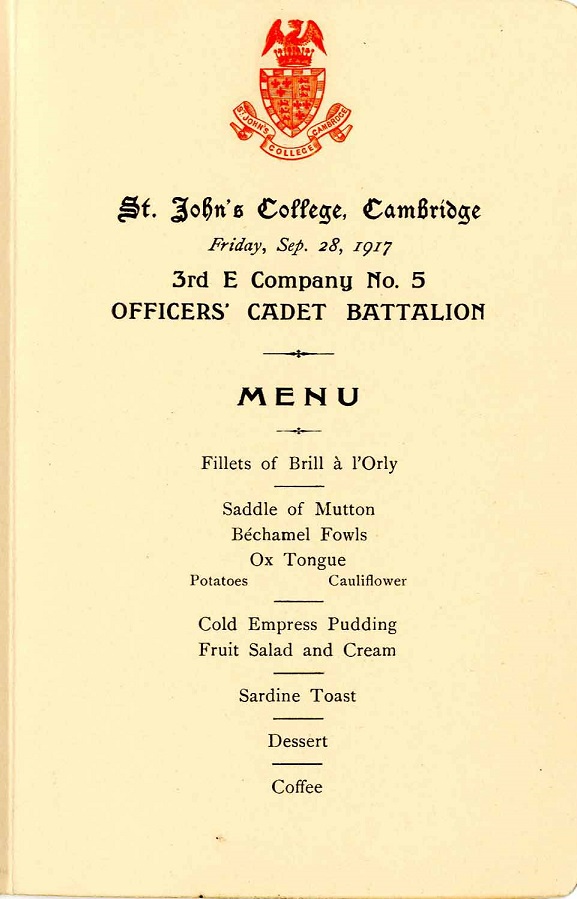
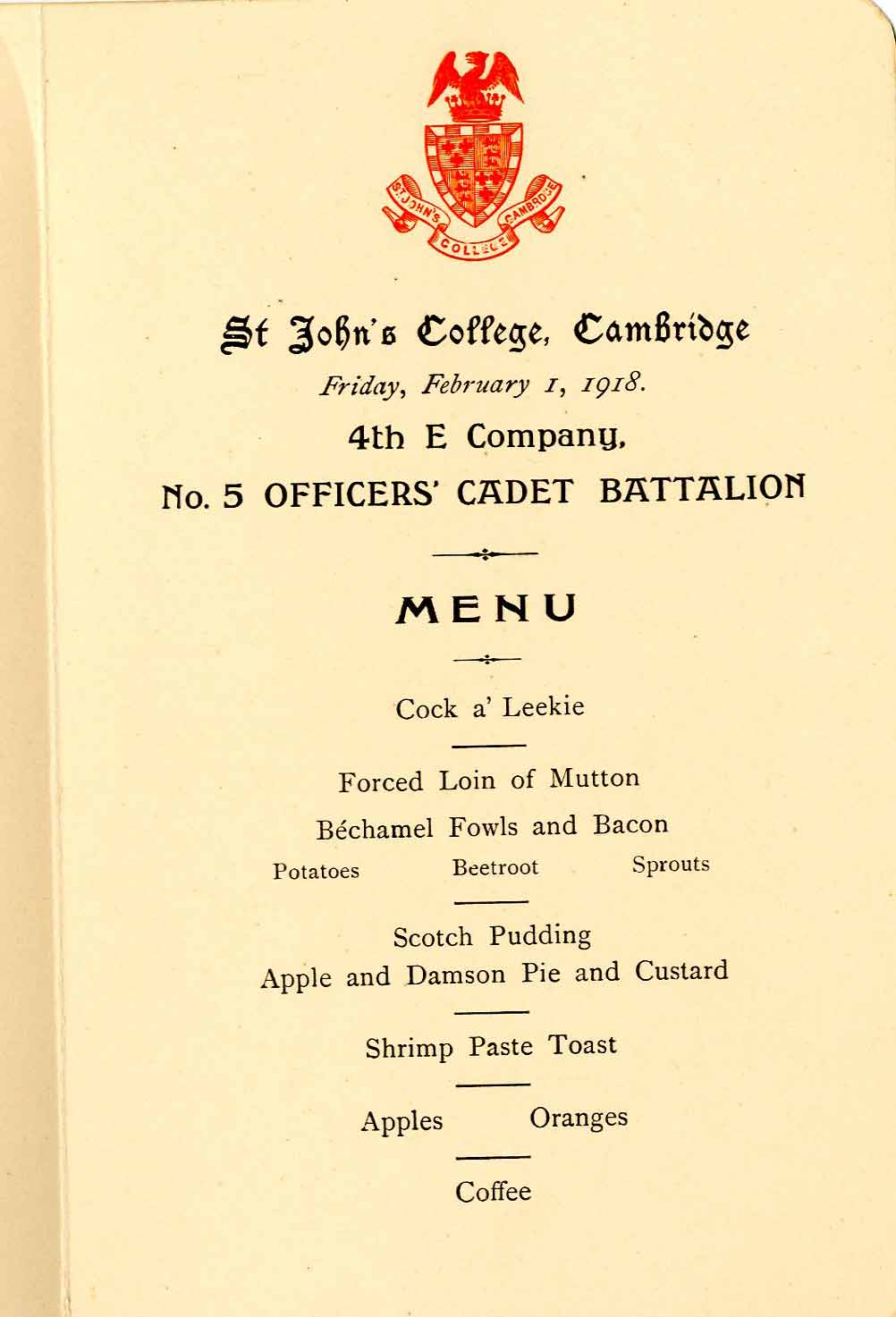
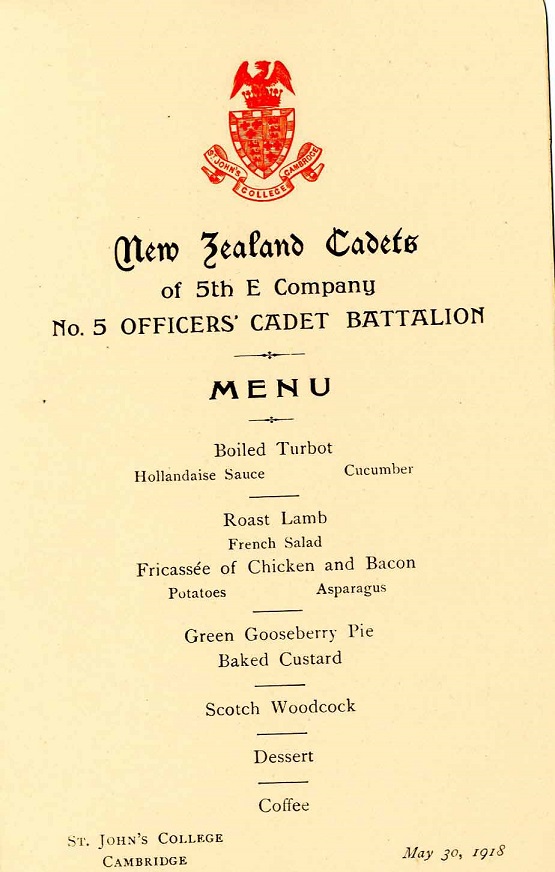
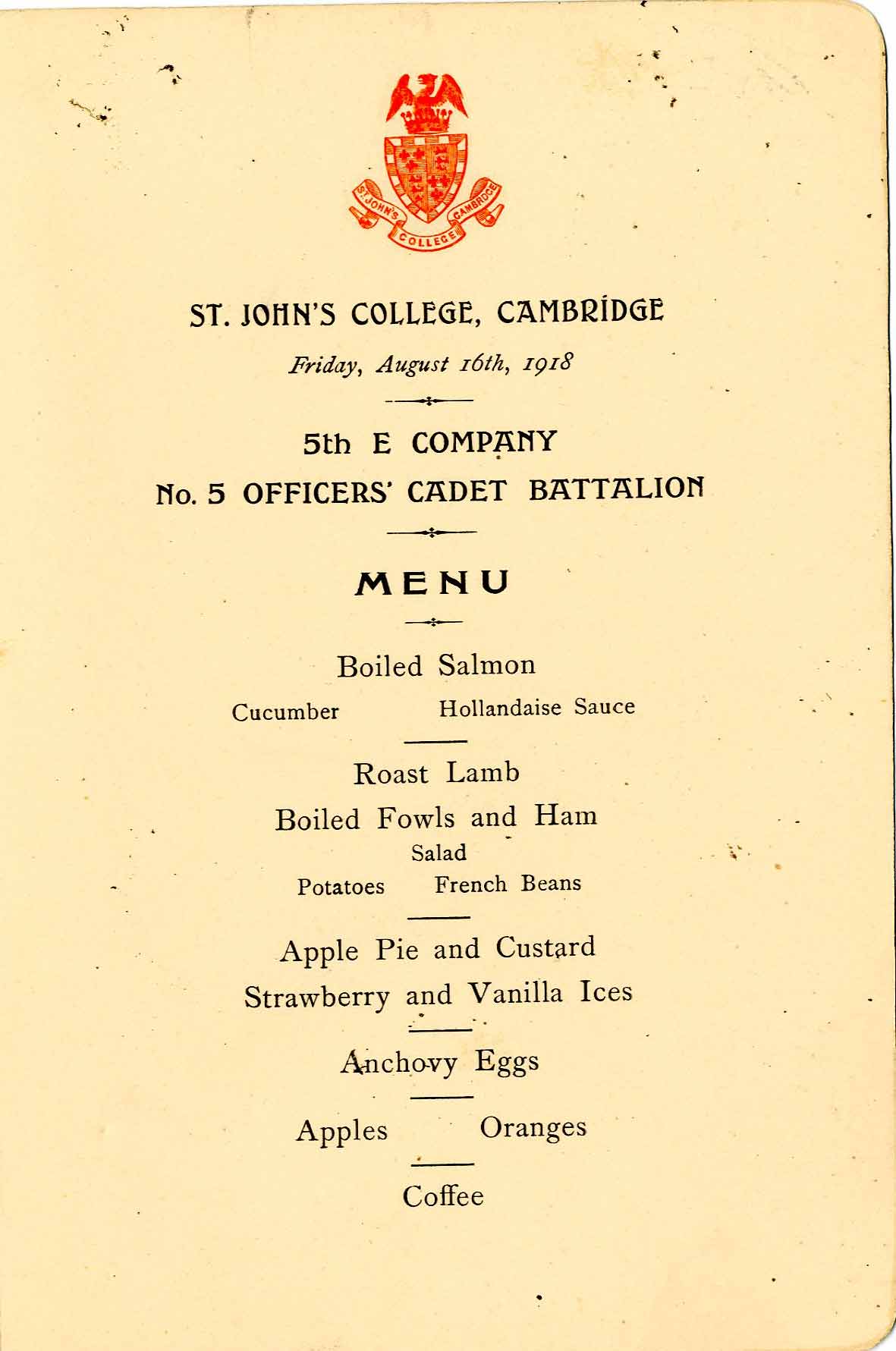
Wartime rations at SJC
28 July 2017
Dietary Restrictions: wartime rations at SJC
Today restricting one's diet is quite common. We all know someone who is vegetarian or vegan, someone who doesn't eat gluten or dairy or someone who is reducing their sugar, fat or salt intake. However, during both wars it was the government encouraging and eventually enforcing Britons to restrict their diet. Rationing was introduced in 1917 and again during World War II. Ration cards did not disappear until 1954. The College's Archive collection contains a number of ration notices for Fellows and junior members from World War I until 1949.
World War I
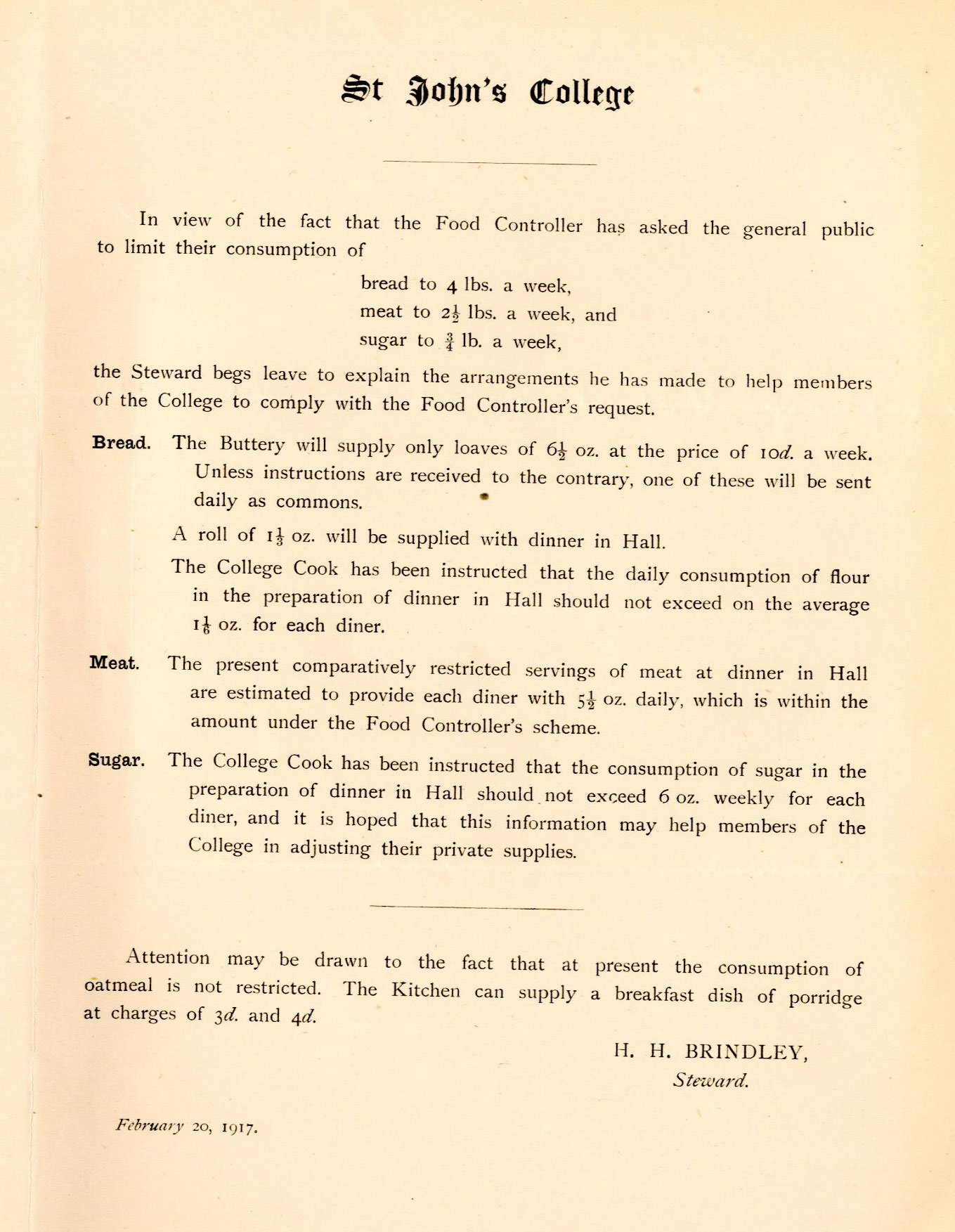
Following three years of war, in January 1917, Germany started using submarines to sink all ships headed to Britain in an attempt to starve Britain into submission. To meet this threat to the food supply voluntary rationing was introduced in February 1917.
The allowance under this scheme was based on three staples of the daily diet - bread, meat, and sugar. The College as a provider of meals, volunteered to reduce its consumption of these foodstuffs.
Although this voluntary scheme had some effect, more was still needed. Shortages continued and although wealthier people could still afford food, malnutrition was seen in poor communities. To try to make things fairer and ensure that everyone received their fair share, the government introduced rationing in 1918. Ration cards were issued and everyone had to register with a local butcher and grocer. The first item to be rationed was sugar in January 1918, but by the end of April meat, butter, cheese and margarine were added to the list. Some foods were still in short supply even after the war ended. For instance butter remained on ration until 1920.
World War II
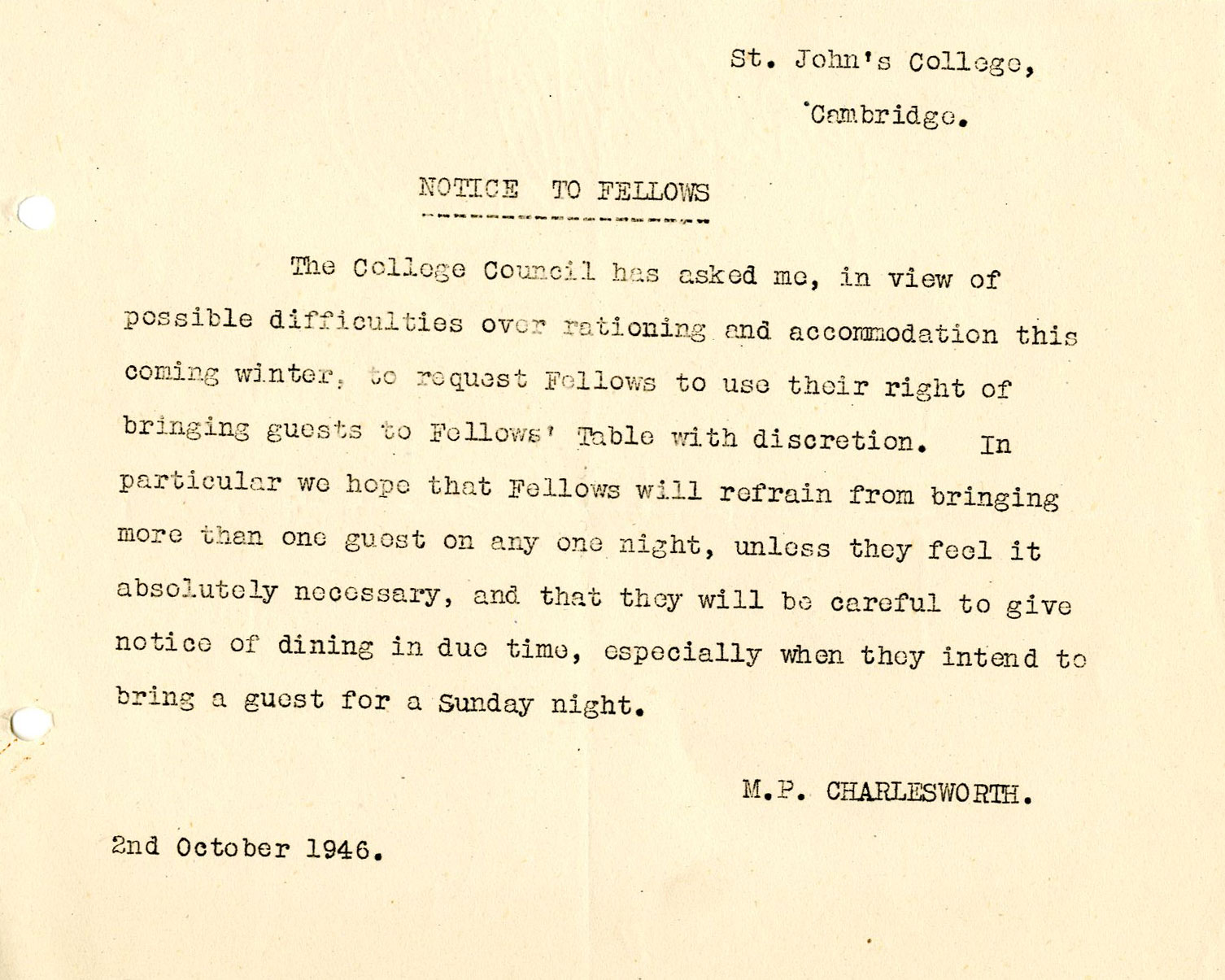
Cambridge itself experienced, during these years, the same round of air-raid precautions, black-out, and steadily increasing shortages as all other places in England. After the Second World War began in September 1939 the first commodity to be controlled was petrol. On 8 January 1940 bacon, butter and sugar were rationed. This was followed by successive ration schemes for meat, tea, jam, biscuits, breakfast cereals, cheese, eggs, lard, milk, and canned and dried fruit.
As in the first war, the College was forced to limit its consumption of rationed foodstuffs. Throughout the war it issued notices to Fellows and undergraduates regarding the rationing of food. A notice from 1943 pasted in the front of the Kitchen Suggestion Book (SJGR/2/8/3) reads:
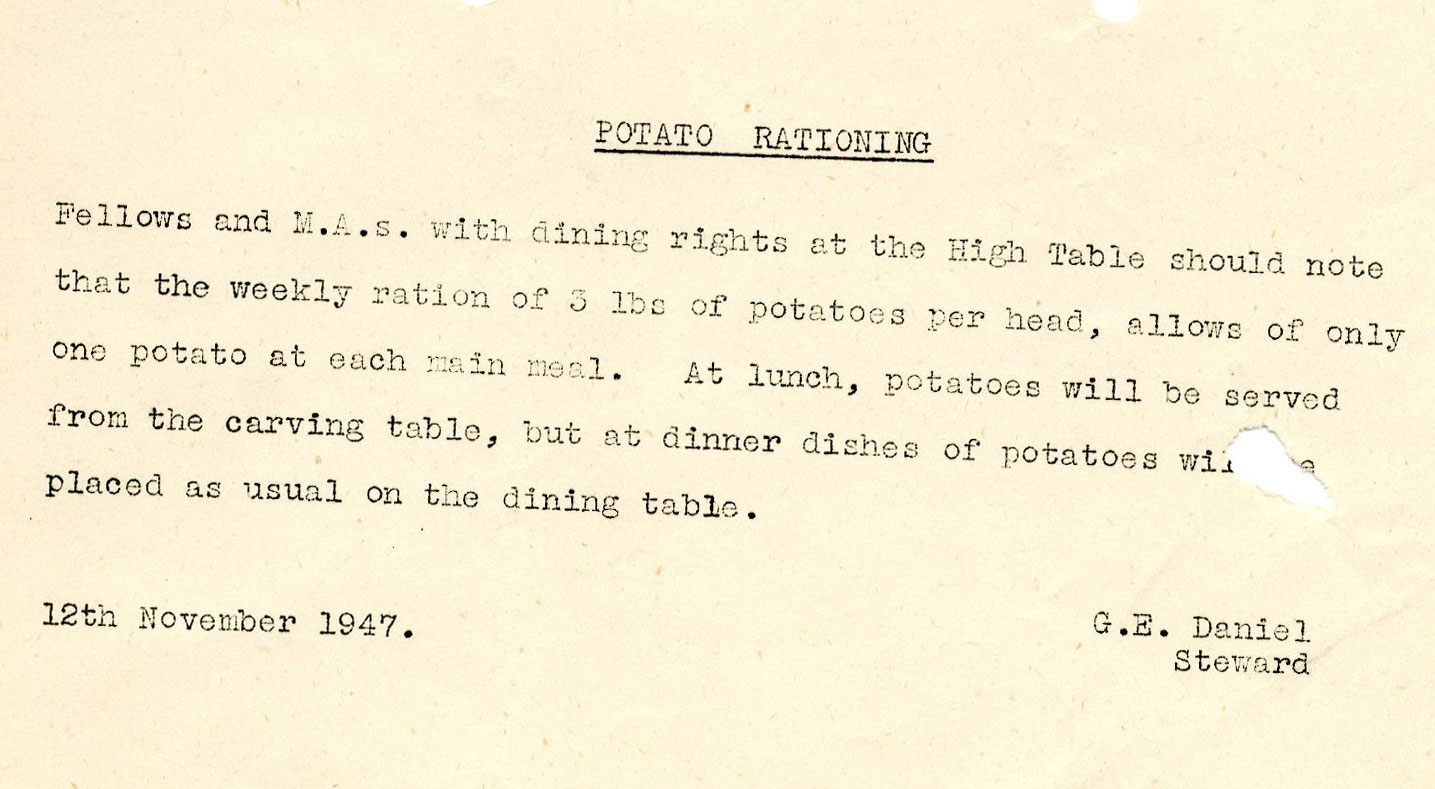
It is the desire of the Steward and the Kitchen that you should be fed as well as possible within the limitations set by the Ministry of Food. Helpful suggestions towards this end are welcomed and will be seriously considered. Complaints should be made direct to the Kitchen Manager. (21 January 1943)
Fourteen years of food rationing in Britain ended at midnight on 4 July 1954 when restrictions on the sale and purchase of meat and bacon were finally lifted.
Below are a series of rationing notices issued to College members during World War II. Note that in addition to bread, meat, sugar and butter potatoes were rationed.
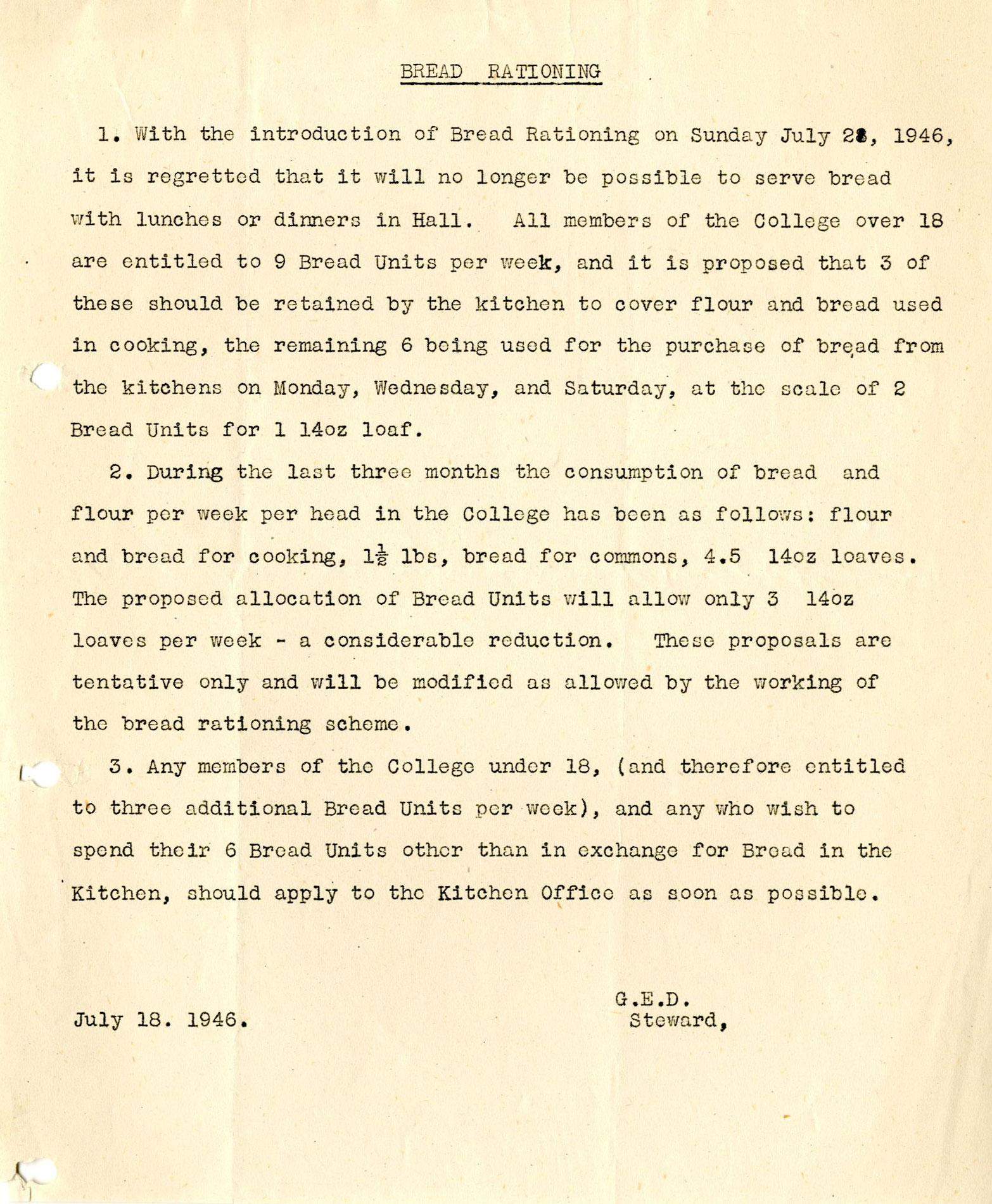
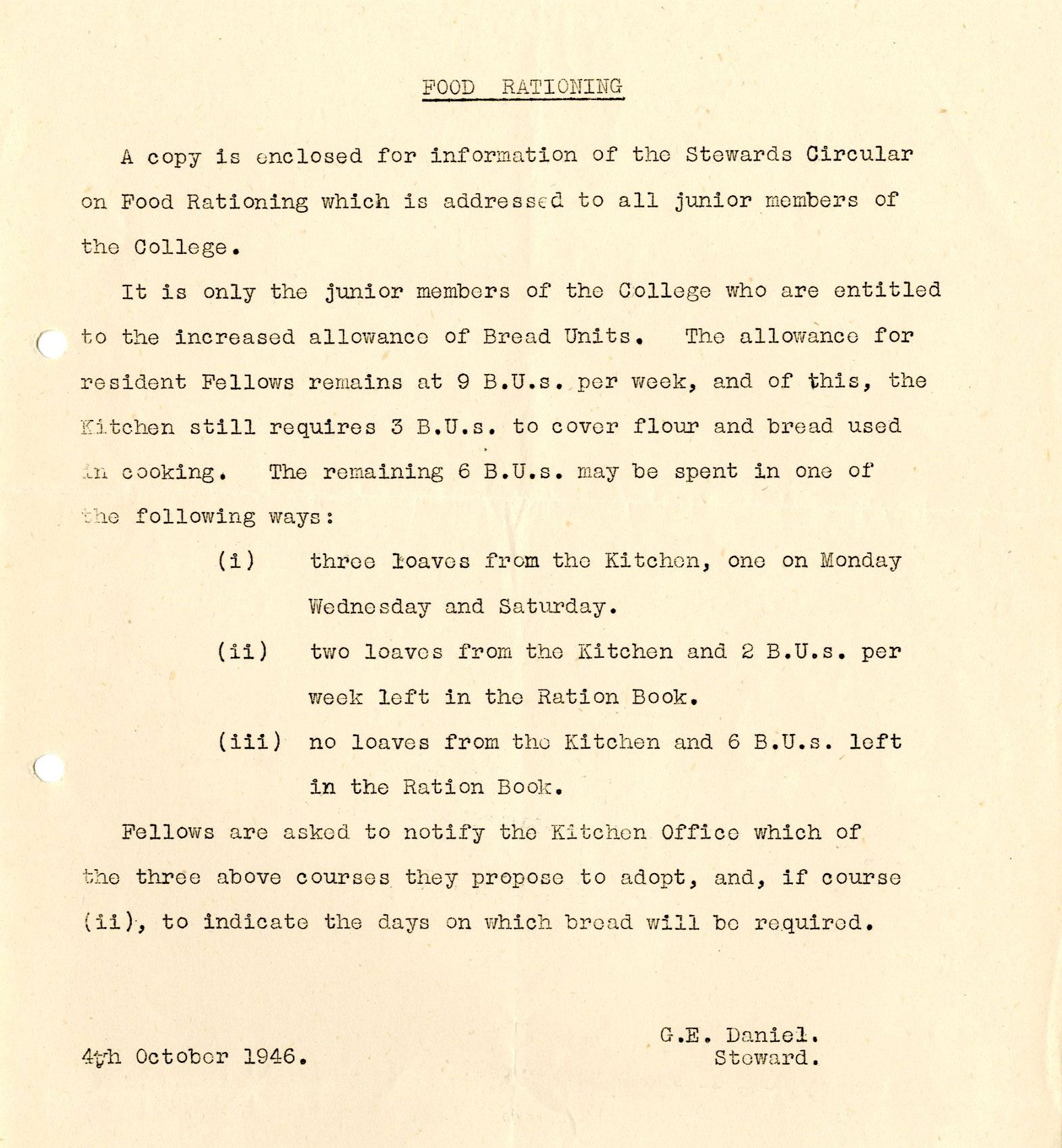
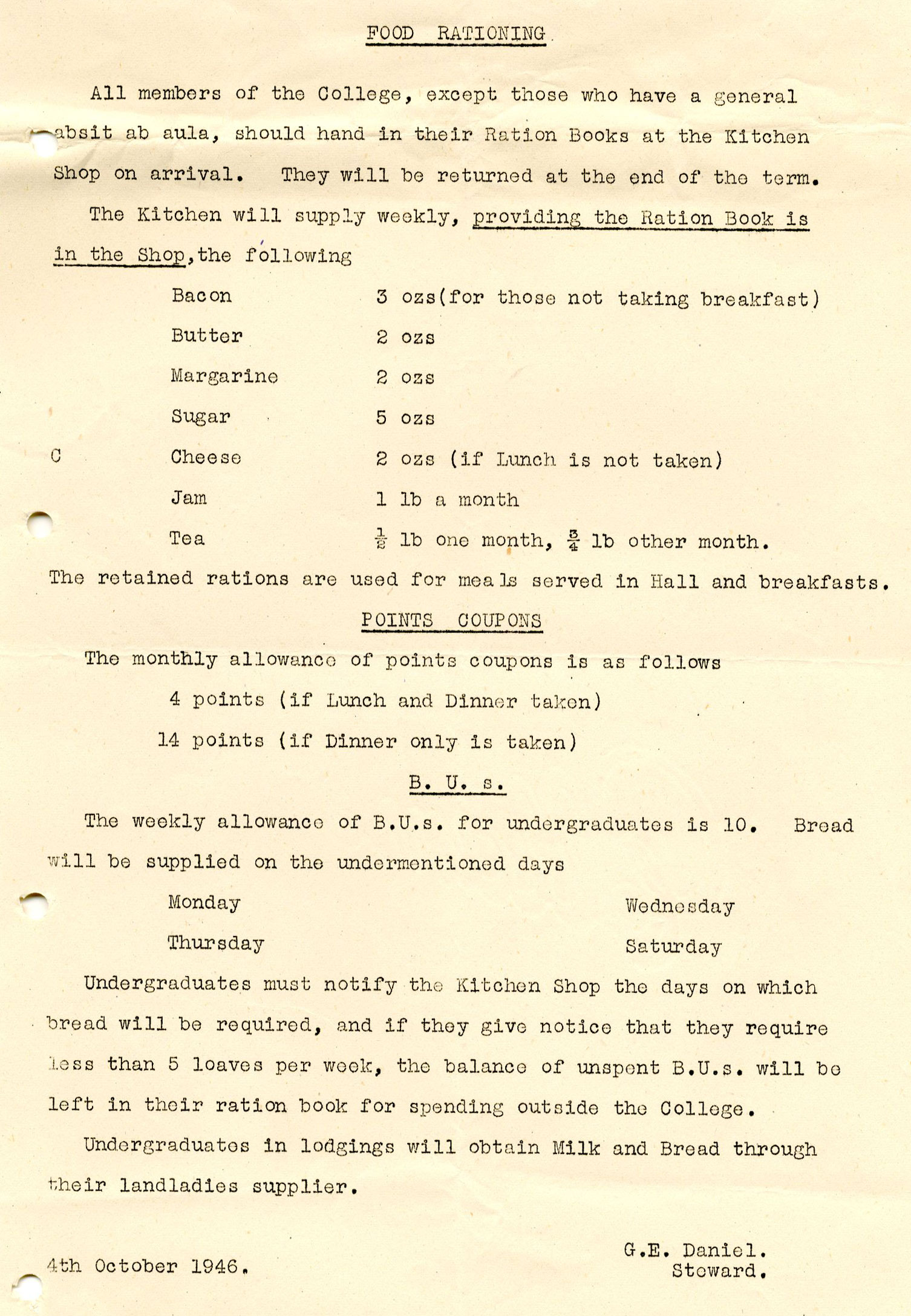
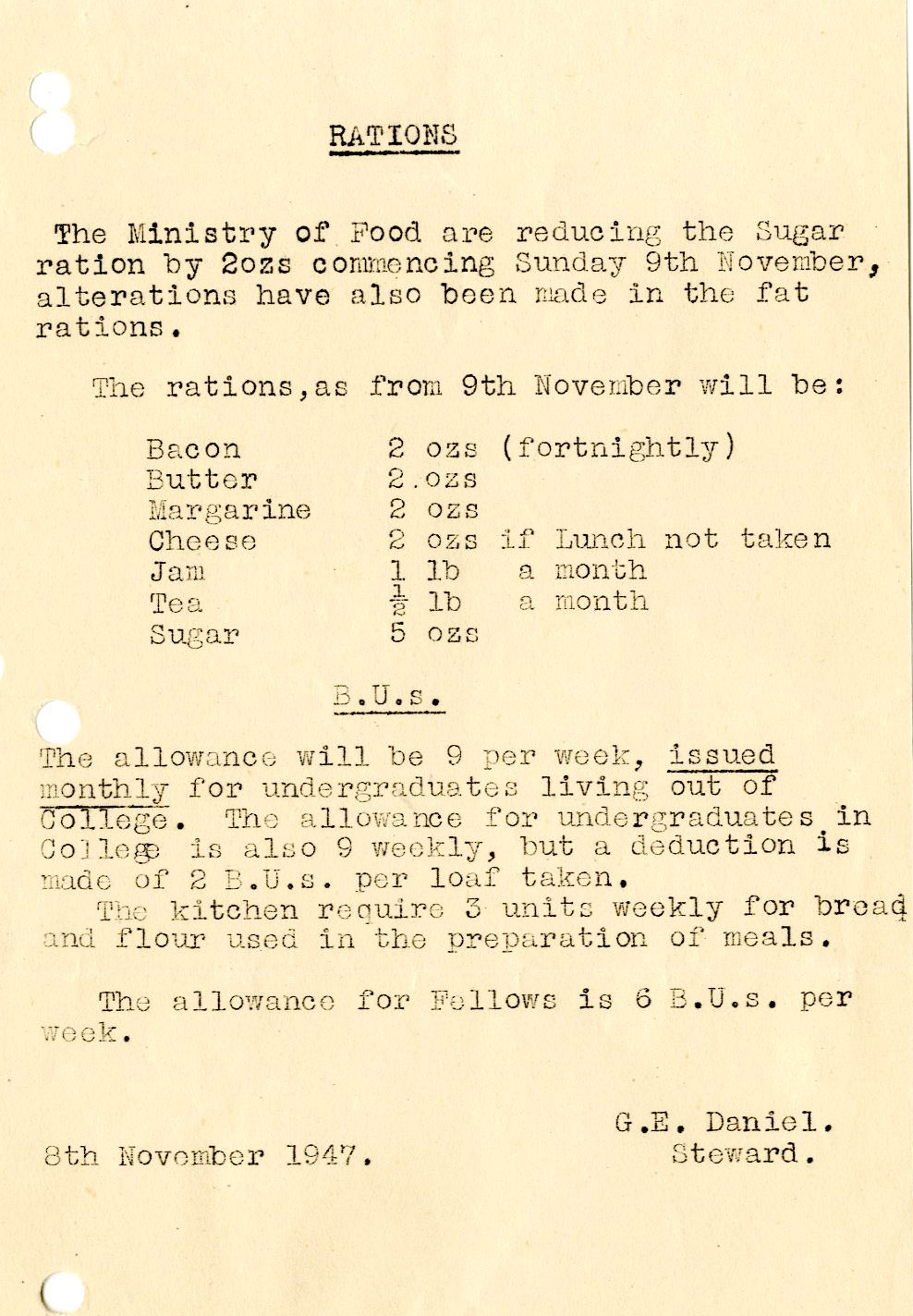
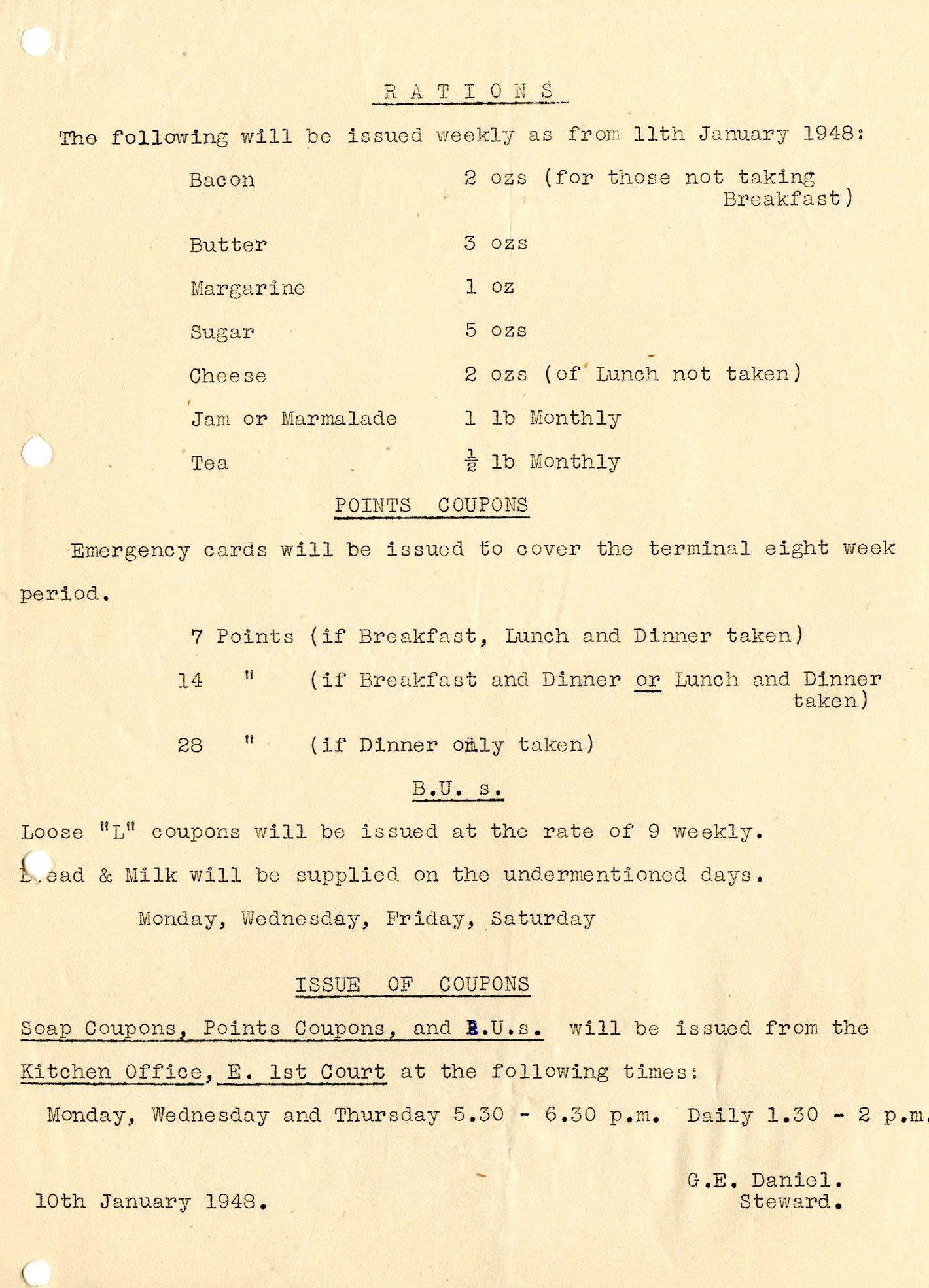
A 14th century Knight's livery
16 June 2017
Fashion Rules: a 14th century Knight's livery
The idea of fashion and what makes an item of clothing desirable and ‘trendy’ is not new. In the Middle Ages it was the aristocracy and the royal family who caused a stir with their wardrobes.
Only the wealthy could dress in fashionable clothes. Laws dating back to the Romans restricted ordinary people in their expenditure. These were called Sumptuary Laws. English Sumptuary Laws were imposed by the monarch to curb the expenditure of the people and to control behaviour and ensure that the class structure was maintained. Sumptuary laws might apply to food, beverages, furniture, jewellery and clothing.
All those with expendable income would have been aware of the sumptuary laws. The penalties for violating them could be harsh - fines, the loss of property, title and even death in some extreme cases. Medieval society was highly stratified and individuals knew their place. Clothing provided an obvious and clear method of distinguishing one’s place in the social hierarchy in a society which was largely illiterate.
The first record of sumptuary legislation is an ordinance of the City of London in 1281 which regulated the apparel, or clothing, of workman. These related to workers who had working clothes supplied by their employer as a part of their wages – this is what the phrase and clothes suitable to his estate in the document bellows refers to. Fashions and trends between countries were frequently imitated and this first law may have been copied from one on the continent. The second record of sumptuary legislation occurred during the reign of King Edward II (1284-1327) related to food expenditure. King Edward II issued a proclamation against 'outrageous consumption of meats and fine dishes' by nobles.
The next records of sumptuary legislation occurred during the reign of King Edward III (1312-1377). King Edward III passed these Sumptuary Laws to regulate the dress of various classes of the English people, promote English garments and to preserve class distinctions by means of costume, clothes and dress.
The document below is an indenture of enfeoffment from the 14th century. The knight William de Manneby [Manby] has transferred the rights to his to the Manor of Manneby, its appurtenances, the windmill and two plots of meadowland to Thomas de Multon of [Frankton] and his wife Elyzabeth in exchange for ten years of his service. In exchange for the property, de Multon and his wife agreed to feed William from their table and to clothe in a manner ‘suitable to his estate’ for the term of his tenure. The de Multons also pledge to feed and clothe William’s three children for the period of his tenure, on the condition that the children also provide service.
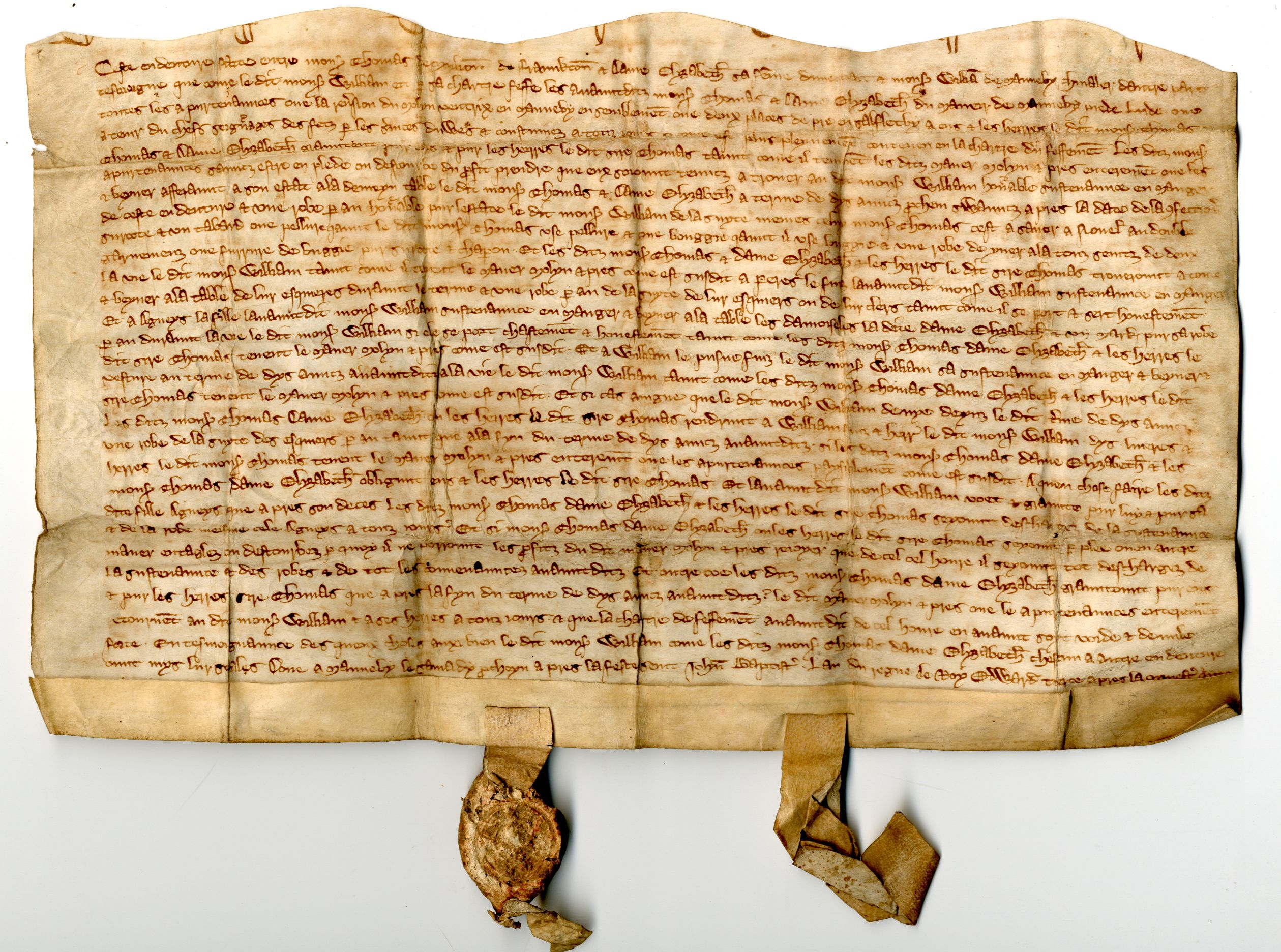
The indenture is part of a collection of deeds belonging to the Hospital of St John. The collection includes deeds for Manby with an advowson, Saltfleetby, Cateby, Grimsby Parva, and Thorgramby [Thorganby], Lincolnshire. They range in date from 1295 to 1493 and are in Latin, French and English. The document discussed here is in French.
The indenture is transcribed as:
Indenture, whereby, whereas William de Manneby, knight enfeoffed[1] to Thomas de Multon of ffraunkton and Lady Elyzabeth his wife of the Manor of Manneby near Lude [Louth], with the appurtenances, the reversion of the wind-mill and two plots of meadow in Salfletby, to hold of the lords by service; Thomas and Elyzabeth grant to William honourable sustenance in eating and drinking at their own table for the term of ten years from the date of the indenture, and clothes suitable to his estate, that is to say, at the new year a double surcoat and a tabard, a fur when Thomas wears one and a bouggee[2] similarly, and at All Saints’ Day a winter robe of two pieces, consisting of a surcoat of buggee and a chaperon[3]. And Thomas and Elyzabeth will find food and drink for William’s son, Peres, at the table of their esquires, and provide him clothes such as they give their esquires, for William’s life, so long as he behave and serves them honestly. For Agneys, the daughter of William, they promise food and drink at the table of Elyzabeth’s maids, and one mark yearly for her clothes during Williams life-time, so long as she behaves chastely and honestly. For William, the younger son of William, they promise food and drink and clothes during the life-time of William the elder. If William dies before his ten years are up, Thomas and Elyzabeth will give to William his son ten liveries and an esquire’s robe each year until the term is completed. After William’s death, Thomas and Elyzabeth have no more concern with the support of Agnes. And if they cannot get the profits of the manor, mill and meadows, they are discharged from the support of William and his family for ever. After ten years, the manor etc: shall revert to William or his heirs.
At Manneby, Saturday after the feast of St John the Baptist, 4 Edward: III[4].
[1] In the Middle Ages, especially under the European feudal system, feoffment or enfeoffment was the deed by which a person was given land in exchange for a pledge of service. This mechanism was later used to avoid restrictions on the passage of title in land by a system in which a landowner would give land to one person for the use of another. The common law of estates in land grew from this concept.
[2] Bouggie or buggie [sic] is most likely bogee from the Medieval French for a fur made of lamb which originated in North Africa and is sometimes referred to as ‘astrakan’. This fur was not intended for warmth but for decoration.
[3] In the early 14th century this was a utilitarian hood with a small cape but later on in the century it evolved into a complicated and fashionable hat worn by the wealthy in town settings.
[4] 1 July 1330/31
The St. John's Hungarian Ball, 1957
3 March 2017
The St. John's Hungarian Ball, 1957
In the early hours of the 4th November 1956, Soviet tanks thundered through the streets of Budapest. Their objective was to seize power of the capital and bring Hungary back under Soviet control, after several weeks’ worth of intense social unrest, a nationwide revolt, and the instigation of a new liberal Hungarian government (directed by Imre Nagy) in October 1956. Orders for the attack on Budapest came only days after the then leader of the Soviet Union, Nikita Khrushchev, had agreed to the request of Nagy’s government to withdraw Russian troops from the city. But in the fierce conflict that followed, Soviet forces quashed the revolution, crushing the resistance not only of the Hungarian Army, but also of the many civilians who fought to protect the city from external forces.
The consequences of the 1956 Hungarian uprising and its suppression were devastating. It is estimated that as many as 4000 Hungarians were killed, with thousands more subsequently arrested, imprisoned and executed. Horrified by what had happened, Western powers poured financial aid and resources into supporting the estimated 200,000 refugees who fled Hungary in the months that followed. In Britain alone, an initial quota of 2500 refugees was quickly revised by the government and increased to 12,000 in order to cope with the huge influx of people. By the 9th January 1957, two million pounds had been given to the Lord Mayor’s Fund in order to help those arriving into Britain from Hungary.
Among the Hungarian refugees who came to Britain were around 500 university students, for whom British universities (including Oxford, London, Leeds, Birmingham, Edinburgh and Cambridge) willingly agreed to provide support in the form of temporary accommodation, intensive language courses, and scholarships that would enable them to complete their studies. King’s College and Trinity College were the first to welcome Hungarian students to Cambridge, with many other colleges following soon after.
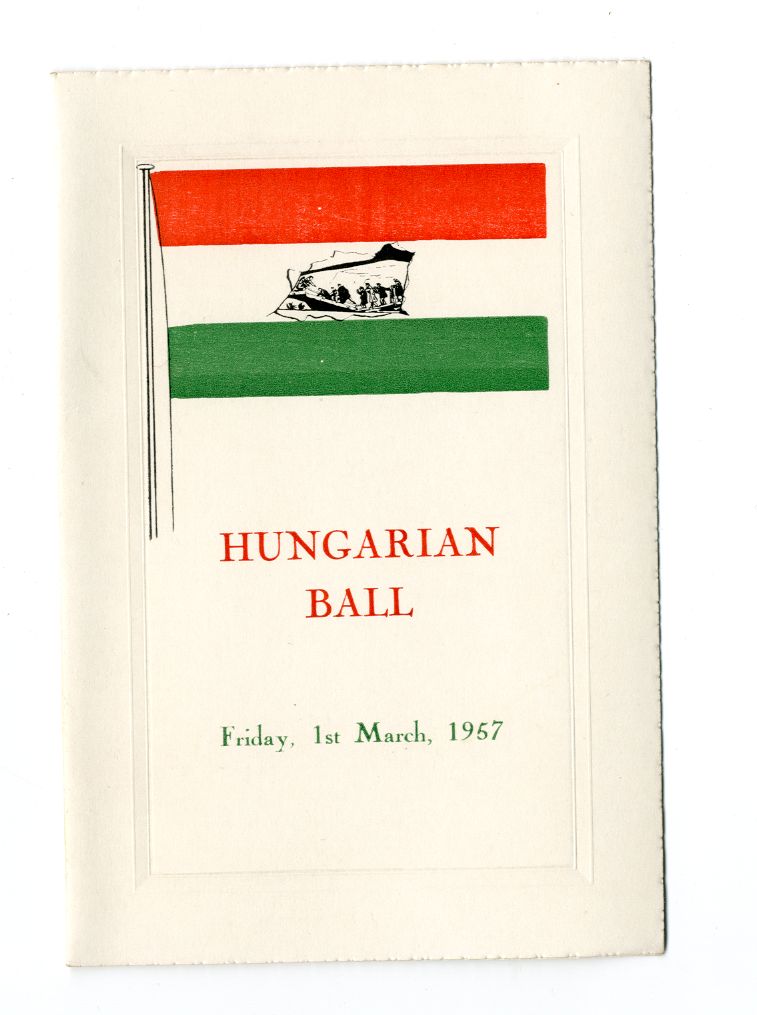
The programme featured here, taken from the collections of the St. John’s College Archive Centre, offers a small but intriguing connection to the events of the Hungarian Revolution and its aftermath sixty years ago. Designed for the College’s Hungarian Ball, which took place on the 1st March 1957, it contains details of the evening’s entertainment, with notable performances by Nat Temple and his Orchestra, the George Melachrino Trio, and a cabaret which involved a piece by the Lithuanian-born British prima ballerina, Svetlana Beriosova (1932-1998).
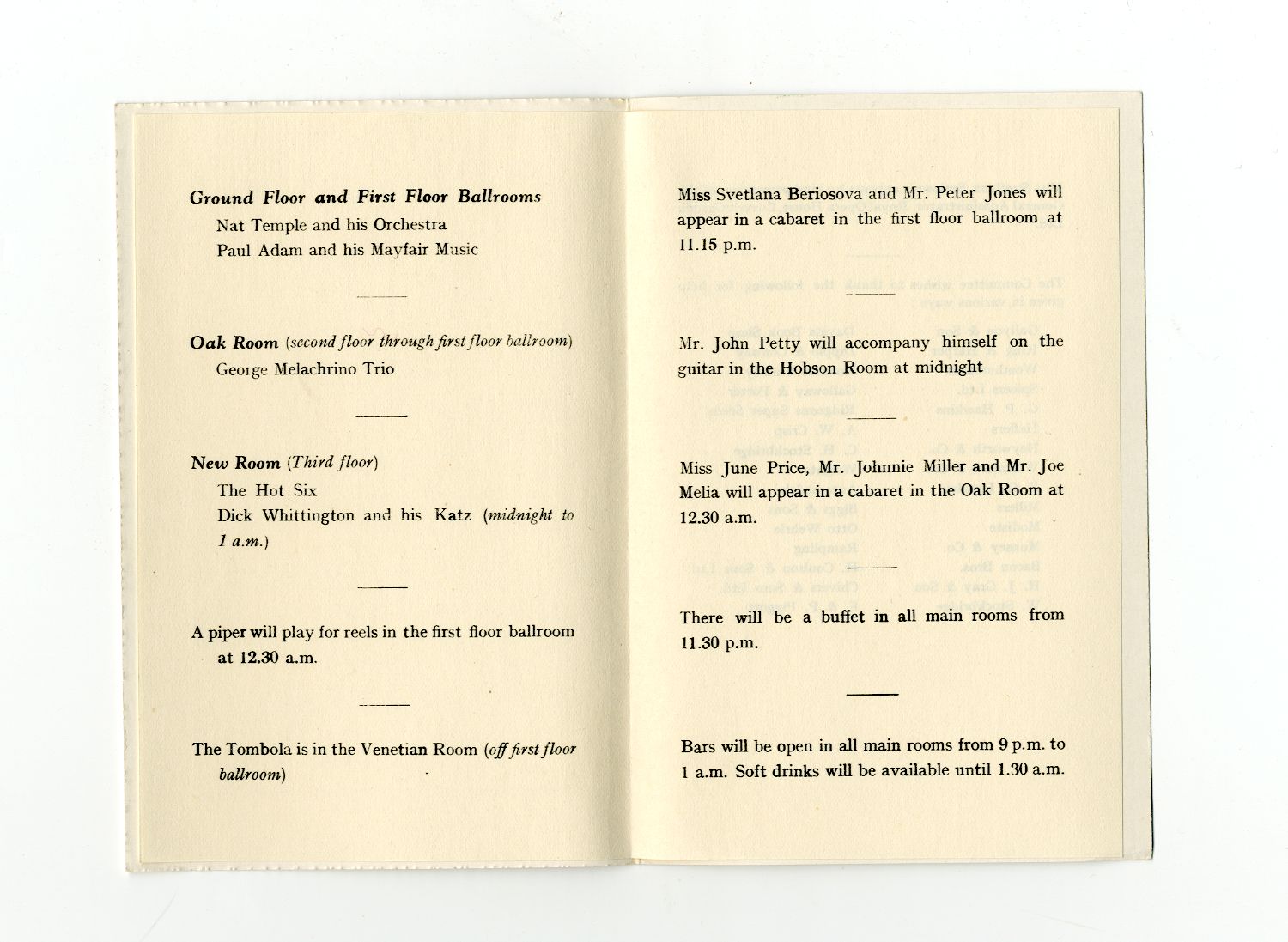
Sadly, as the only evidence we have for the Ball, the programme gives scant information concerning the context for the event, although from what we know, it is possible to suppose that the Ball was organised in aid of refugees, or else perhaps as an official welcome for new Hungarian students staying at St. John’s.
If we look closely at the front cover, we can see the Hungarian national flag with the central 1949-1956 coat of arms removed – a gesture of solidarity with the Hungarian freedom fighters for whom this altered version of Hungary’s flag became a symbol of anti-Soviet feeling. In this particular instance, the coat of arms has been replaced by a black-and-white miniature drawing that depicts refugees climbing onto a raft-like object. The framed outline of the drawing mirrors the shape of Hungary. As a poignant portrayal of ordinary individuals fleeing persecution, the image both captures the mood of a specific historical moment and speaks to the tragedy of the ongoing refugee crisis of present times.
For further information about the experience of Hungarian student refugees at British universities, please see “Just Like Other Students”: Reception of the 1956 Hungarian Student Refugees in Britain by Magda Czigány (Cambridge, 2009).
Were you present at the Ball in 1957? If so, we would love to hear from you.
This article was contributed by Eleanor Swire
Music, Meals and Memories
19 May 2016
Music, Meals and Memories: Delving into the St. John's College May Ball Collection
Today, the St. John’s College May Ball is considered one of the most spectacular parties in the world and a highly-anticipated event in the College calendar. With the exception of 1910, (following the death of King Edward VII) and between the years during and immediately after World War One, St. John’s has held its Ball annually in June since at least 1888. Much has, of course, altered during this time. Throughout the Ball’s 100-year plus history, institutions and traditions have come and gone, as have tastes in food, entertainment and attire. The collection of May Ball material currently held in the St. John’s College Archives - which includes an extensive range of programmes, tickets, photographs, posters, financial accounts and menu cards - documents these cultural shifts and so provides a fascinating insight into an important aspect of the College’s social history. To mark the opening of a new May Ball exhibition in the St. John’s College Archive Centre next month, we take a closer look at some of the pieces from the collection from across the decades to consider how the Ball has been shaped by generations of attendees.
The Guest List
There is no evidence for how many individuals attended the first Lady Margaret Ball in 1888, but in its early history, the Ball appears to have been a more intimate affair, held in the Master’s Lodge with supper in the Senior Combination Room. Dancing took place in the Hall – one can make out the lavish decorations used for the 1898 Ball in the photograph below.
In the twentieth century, the extent of the Ball continued to expand across the College site, with guests now moving freely between both sides of the river and out onto the Backs. By the 1960s, multiple performances were staged simultaneously in different locations, and by the early 1990s, a penchant for themed balls saw the whole of the College re-imagined as a parallel world. Early examples of themed Balls include ‘The Jungle Book’ (1993); ‘Catalonia’ (1994); ‘A Midsommer Night’s Dreame’ (1996); ‘Venetian Carnival’ (1998); and ‘Orient Express’ (2000). The growth in the size and scope of the Ball has been reflected in the increase in ticket prices over the decades which, even allowing for long-term inflation, has more than doubled since 1970.
Members of the College have always held priority for tickets to the St. John’s Ball. Female fellows and students were not admitted as members of St. John’s until 1981, yet women could and did attend the College Ball prior to this as guests of their male Johnian counterparts. Colour-coded tickets, such as those shown here for the 1929 Ball, reinforced the difference between Johnians and their partners: blue tickets for the gentlemen and pink tickets for the ladies. By the 1950s, however, coloured tickets had fallen out of favour and were replaced with a neutral plain, white card.
The Menu
The series of menu cards in the College’s May Ball collection enables us to trace how particular dishes have fallen into and out of fashion over time. Up to the mid-twentieth century, French cuisine was very popular and the dinner menus were typically printed in French, rather than in English. One of the earliest extant menu cards, dating from 1921, includes salmon in a ravigote sauce, baked ham, crab farci (a classic French appetizer in which the shells are stuffed with breadcrumbs, butter, crab meat and seasonings), meringues, pineapple a la Cussy, bonnes-bouches de fois-gras, and to finish, petite marmite au depart – a type of aromatic broth made from meat, vegetables, and seasonings, served in the small pot in which it has cooked. The seven-course dinner menu for the 1898 Ball, featured below, includes duck, quail, pigeon, beef, and for dessert, a rather intriguingly-named Lady Margaret Boat Club (L.M.B.C.) cake!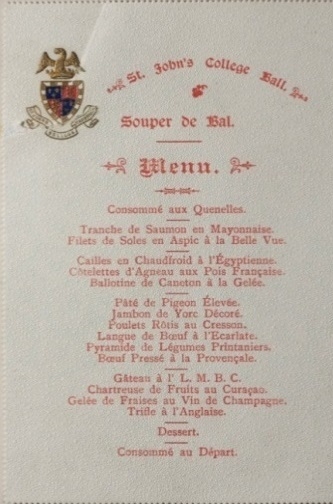
By the 1960s and 1970s, the dinner menu had become far simpler, typically including roast ham, chicken and other cold meats, a staple selection of potato and Waldorf salads, followed by bowls of fresh strawberries and cream. What distinguished the menu of the St. John’s College Ball from that of other Colleges at this time, however, was the presence of ‘cygnet St. Jean’, or ‘roast swan’ - a dish permitted by law to only a very limited number of institutions in the United Kingdom apart from the British monarchy. The serving of roast swan at the May Ball continued until the mid- to late 1980s, at which point it was removed from the menu entirely. In the twenty-first century, the dinner menu has seen the introduction of a vegetarian option alongside more traditional cuts of beef, lamb, duck and guinea fowl.
Alongside the formal sit-down meal, the provision of lighter refreshments at the Ball over the years has also helped to keep guests partying on throughout the night. The menu card for the 1950 Ball lists popular buffet snacks such as Swiss roll, cheese straws and strawberry ices, but with the advent of fast food and increased diversity in cultures and cuisines, today’s May Ball is likely to include stalls selling a range of sweet and savoury treats to cater to different tastes. Crepes, hot dogs, pizza, doughnuts, sushi and copious supplies of alcohol offer a welcome ‘pick-me-up’ when energy levels are flagging. Globalisation has paved the way for more adventurous gastronomic delights as well: in keeping with the ‘Lost Worlds’ theme of the 2014 Ball, crocodile kebabs and camel meatball pittas made an interesting and unusual addition to the usual fare!
While it is difficult to pinpoint exactly when the 6am ‘Survivors’ Photograph first appeared, one can safely say from the evidence of existing programmes that guests have always danced well into the early hours, only to have their photographs taken at breakfast the next day. Today, formal breakfast is served in the Senior Combination Room at 3.30am, and includes a variety of hot and cold options, such as cured meats, croissants, fruit platters and fresh eggs. Sadly, no breakfast menus from the early College Balls have survived, but bacon baps and cups of hot soup were certainly on hand for guests by the early 1960s to quell hungry stomachs at the break of day. Co-ordinating the supply of food and drink for the Ball is a considerable undertaking. For the 2016 Ball, the College Catering Department estimates that it will prepare around 25,000 portions of food to serve throughout the course of the night.
The Entertainment
Well-fed, well-watered and well-entertained: the guests at the St. John’s College Ball have always had plenty of diversion with which to amuse themselves in the long hours between dusk and dawn. Early dance cards, such as those printed in 1898 and 1912, typically featured waltzes such as the Blue Danube and the Lady Margaret Waltz, yet as one moves through the twentieth century, the repertoire expands to include new dances such as the fox-trot, quick-step and tango.
By the 1960s, ballroom dancing has largely given way to headline performances by bands such as Russ Henderson’s All-Steel Band and Ian Stewart and his Orchestra (Stewart being one of the subsequent co-founders of the Rolling Stones). Since then, the Ball has attracted a whole host of artists, including Status Quo (1970); The Troggs (1984), and Hot Chocolate (1996), to perform alongside a range of jazz bands, orchestral ensembles and a capella groups. Guests have not only been spoilt for musical entertainment. Other divertissements, such as massage parlours, jousting, casinos, hot air balloons, coconut shies, shooting ranges, and fireworks have all featured on the May Ball line-up at one point or another.
Examining the documents left behind, one can form a fairly good impression of what the May Ball of yesteryear must have been like. The collections held in the College Archives tell us what people ate, what they wore, what type of music they listened to. Yet the experience of being present at a Ball is less easy to record, and behind the words and images on a page lie countless private memories, concealed from public view. These are left to the imagination.
For further information, see R. Langhorne, “The Lady Margaret Ball: A Note on the Early History of the May Ball’. The Eagle. Vol. LXVIII (Easter 1980) p.p. 27-31.
This article was contributed by Eleanor Swire, Information Services Graduate Trainee, 2015-2016.
Bills, Bills, Bills
2 September 2015
Bills, Bills, Bills
This invoice, dating from the late nineteenth century, is a pro forma found in the account books of the classicist John Edwin Sandys who was elected a Fellow of St John's in 1867. When he became a tutor in 1870, Sandys took charge not only of the academic life of his students, but also their wider activities at the College, down to keeping track of their bills for rent, tuition and even beer. He did this in a collection of immaculately neat account books which are preserved in the Archive.
This particular invoice, found loose in his account book for the period 1878 to 1880, demonstrates the breakdown of charges recorded in Sandys’ accounts. In fact, these are not even as detailed as the books themselves; despite the warning that ‘Undergraduates must pay their own Tradesmen’s bills’, Sandys often has a record of debts to tradesmen under the £5 minimum detailed here, including, on occasion, debts to bricklayers, who would be brought in for alterations or perhaps in the case of unusual damage to a student’s rooms.
Interestingly, in this period the bedmakers were not members of College staff as they are today. They were essentially self-employed subcontractors, who undergraduates could engage as they wished. It would perhaps be interesting to see how many of the students of the late nineteenth century declined to employ a bedmaker, and whether the habits of those who didn’t mirror the behaviour of countless teenage boys who can’t seem to remember to make their beds today!
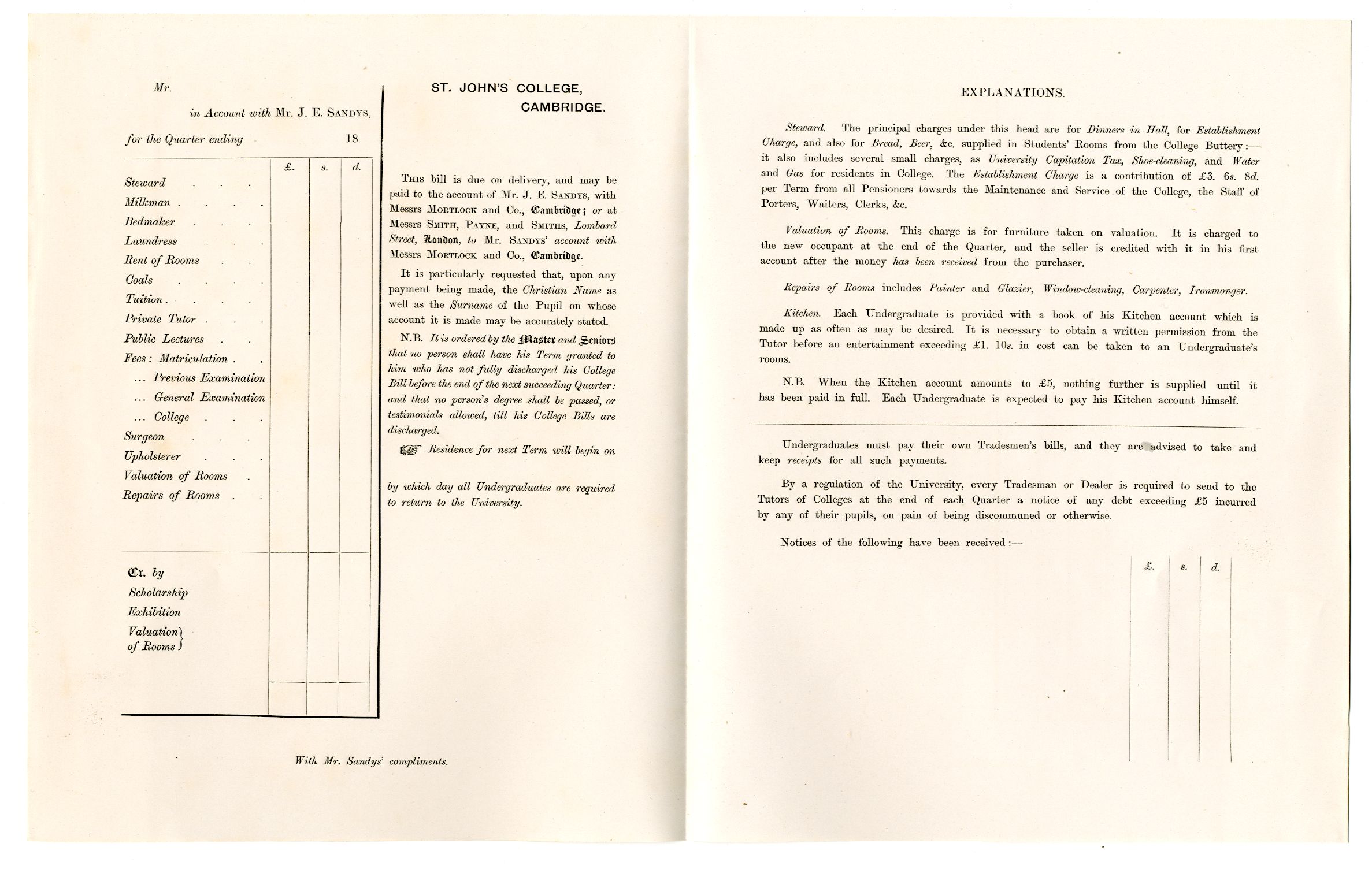
Central Higher Grade Scholarship School
16 June 2015
Central Higher Grade Scholarship School
Found within the admissions papers and correspondence of Donald Macalister were three photographs of school children from Central Higher Grade Scholarship School. The photographs were sent to McAlister by his former student Frank Adkins, who was a teacher at the school. Adkins was seeking McAlister's support and advice in acquiring a new more prestigious post. In his letter to Macalister it is clear he feels that his job at the school was not what he'd hoped for in his career. Adkins came up to Cambridge as a student at the Day Training College in 1893 but applied for admission to St John's a year later. He studied for the Historical Tripos and did will according to his tutors.
In a letter Adkins wrote to Macalister on 13 June 1902 he included three photographs of the upper part of the school and explained that "the dresses the girls are wearing in two of the groups were made in school by the girls themselves".
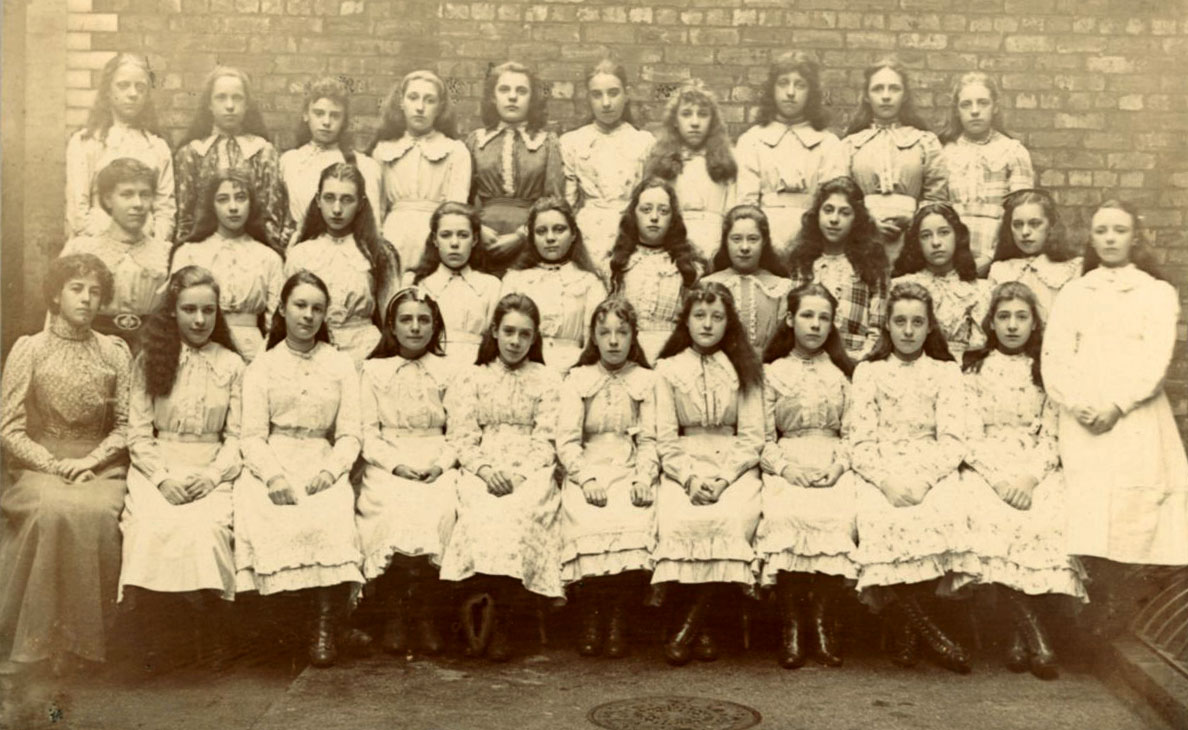
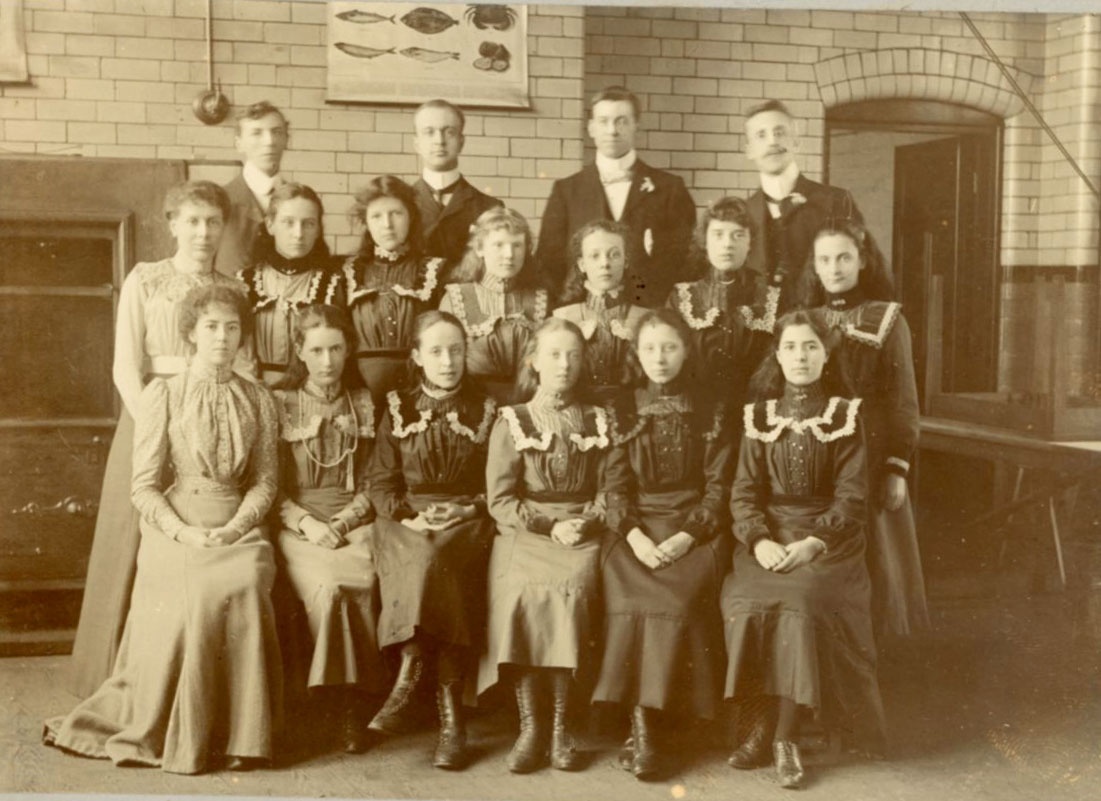
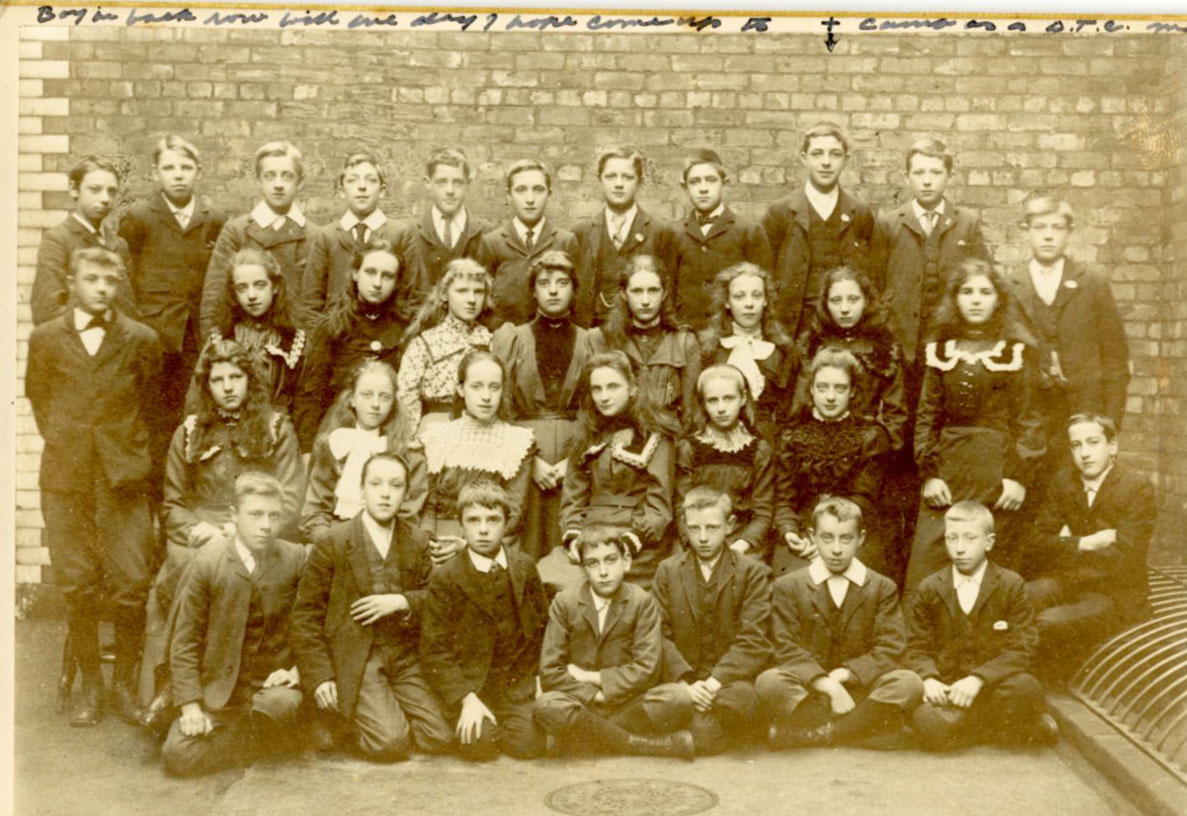
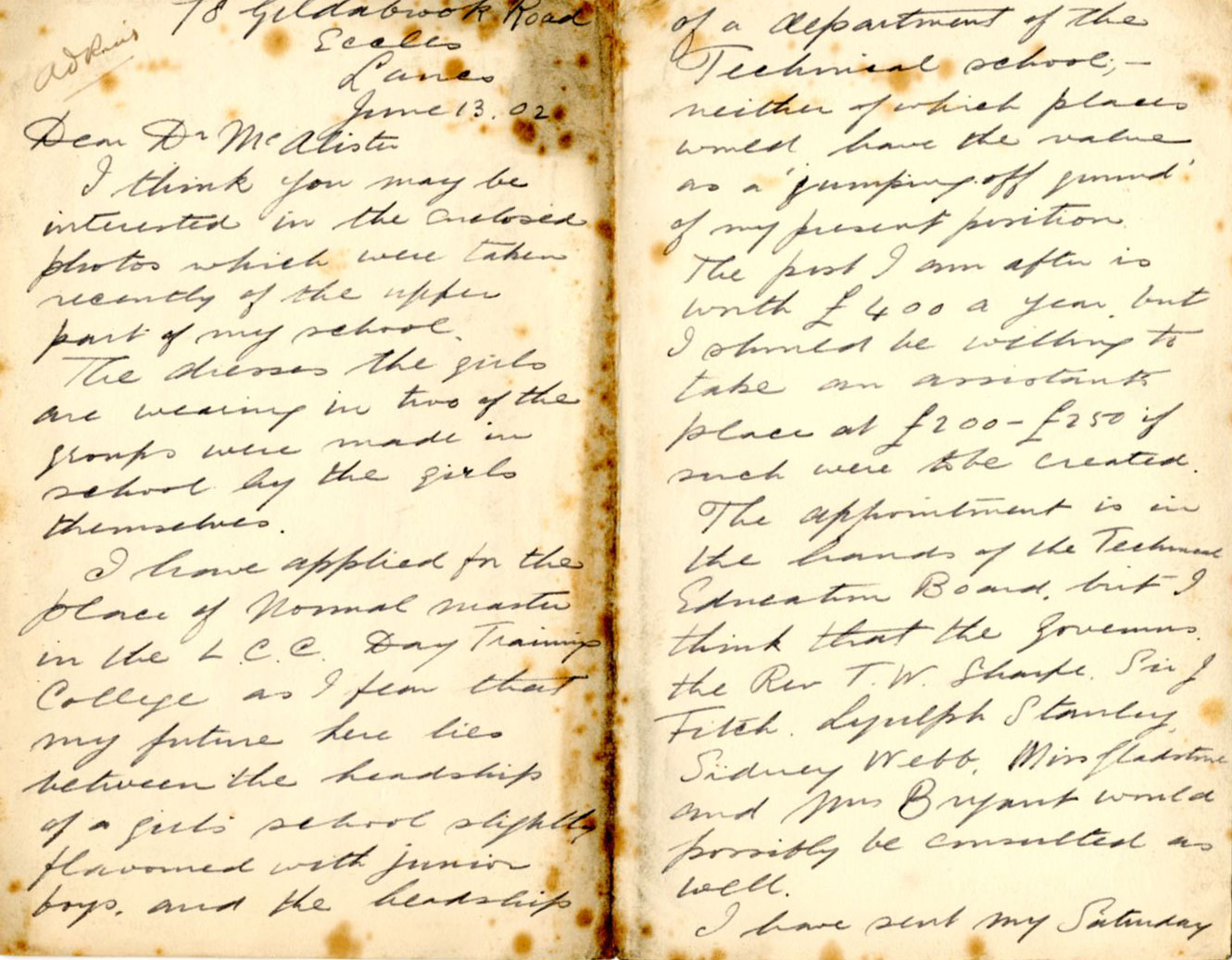
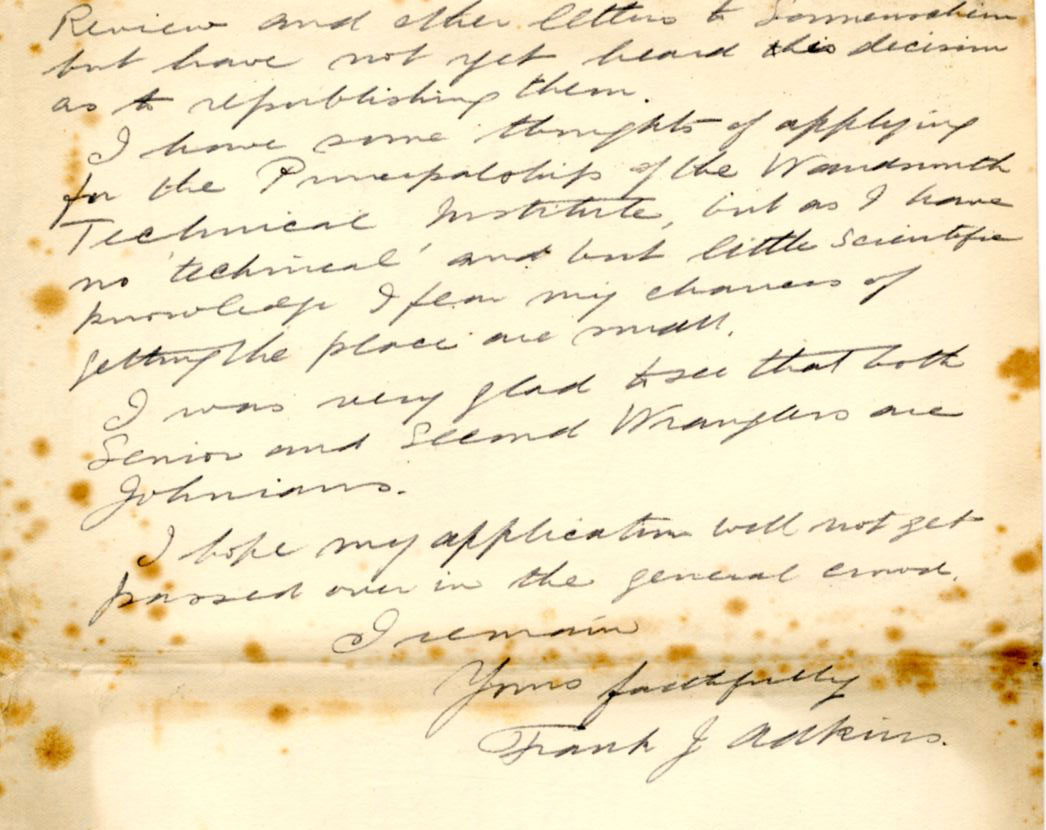
A very important petition
7 May 2015
A very important petition
For students back in the 1860s, College food was as important an issue as it is today. Found amongst the records of the ‘Reform of servants committee’ (1854-1916), this petition, addressed to the then president Rev. Stephen Parkinson, summarizes the various grievances towards catering in the College. This includes:
- A lack of tables
- A lack of waiters (one waiter to six men would apparently be desirable)
- An unsuitable carver
- A lack of good beer (“We are willing to pay any fair and reasonable prices to procure some really good and drinkable beer”)
The petition then goes on to outline the students’ dissatisfaction with the pricing of the food, which in comparison with other colleges (many of which are listed) is extortionate:
“For the sum of 4/2 [shillings/pence], a dinner procured at St John’s College consisting of soup, meat, pastry, cheese & celery, whereas 2/6 only is charged at Magdalene College for a dinner similar in all respects except that fish is substituted for soup on alternate days.”
The rest of the petition can be read below. Whether these complaints were acted upon is unknown.
Article contributed by Richard Sellens, Graduate Library Trainee.
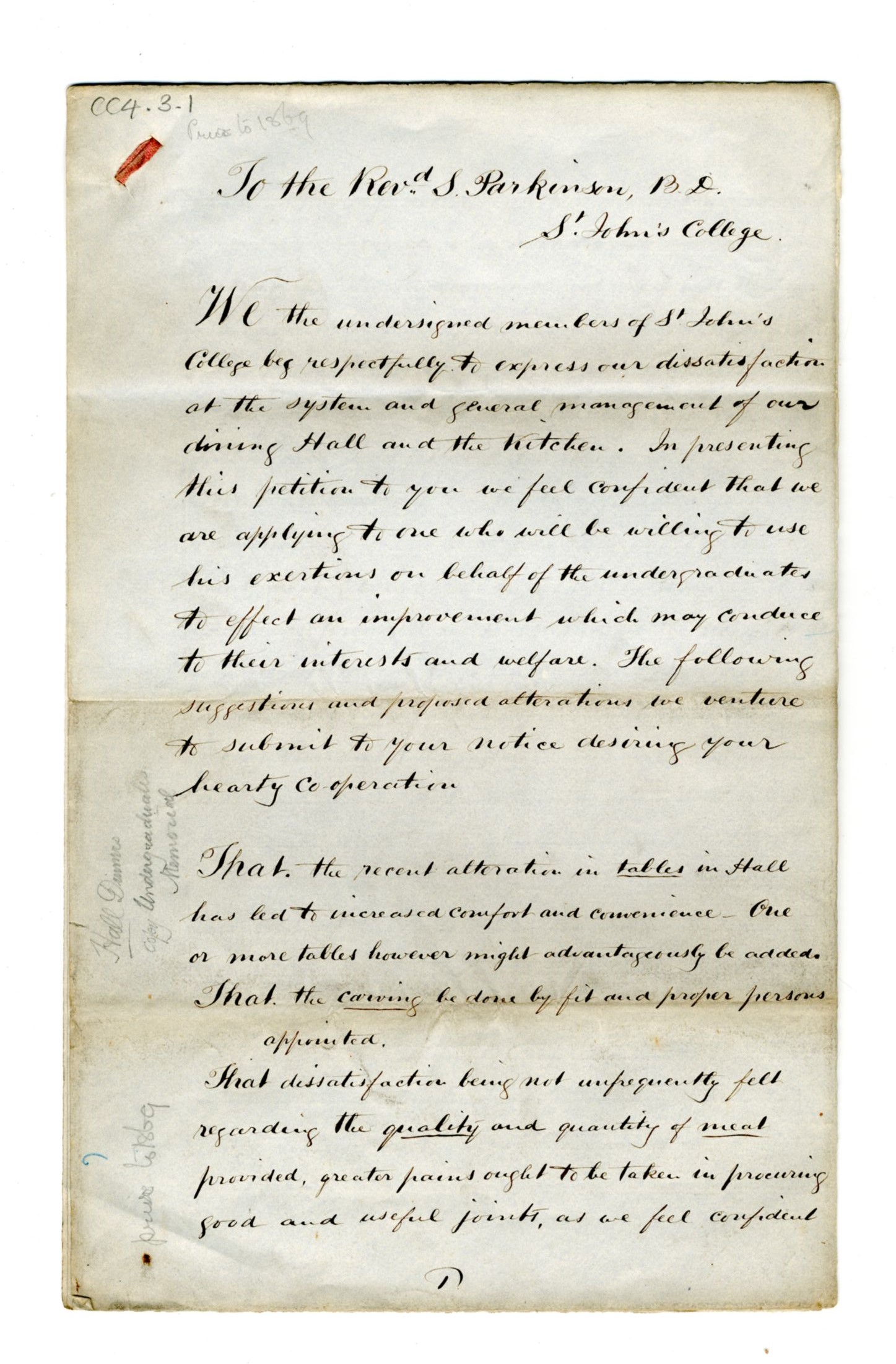 |
|
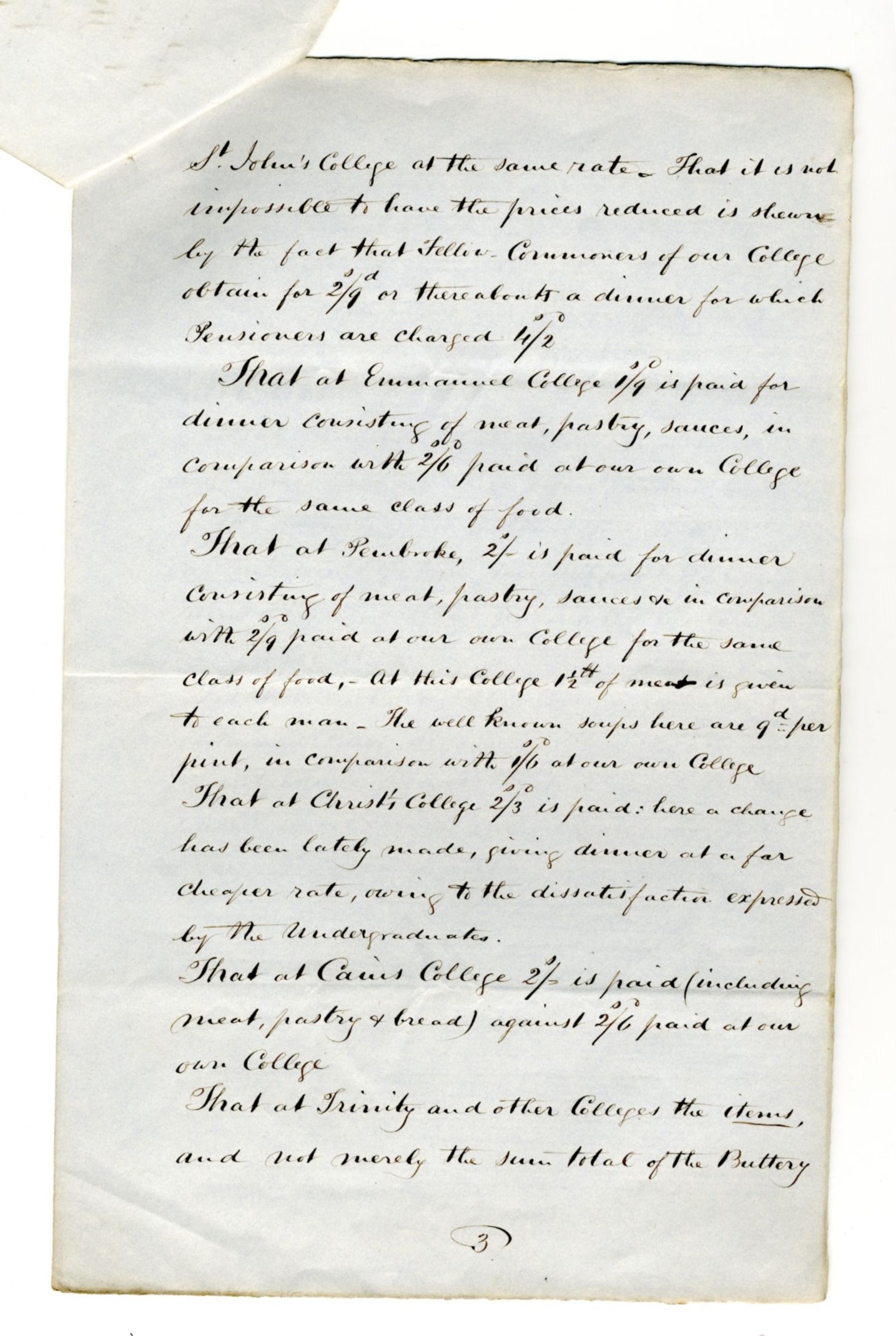 |
|
